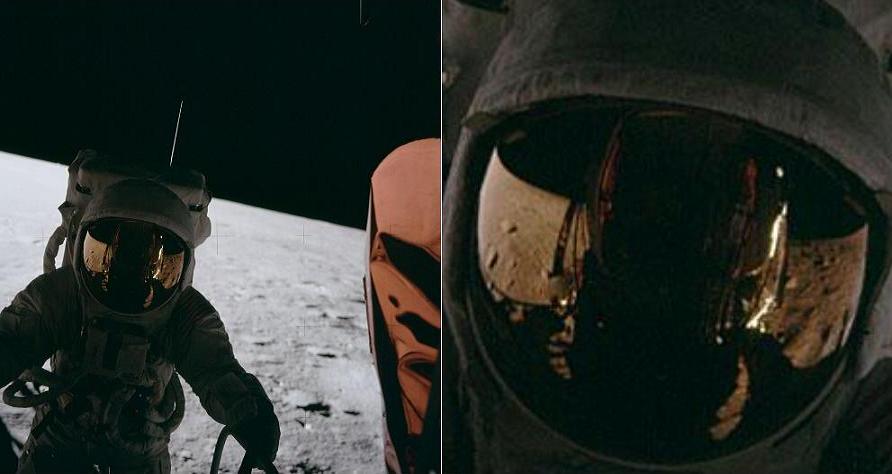 On photo AS12-46-6716, we seem to see too much of the lunar ground. 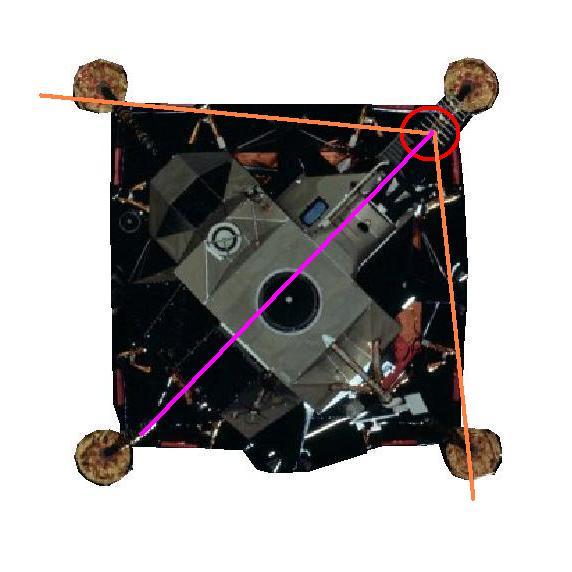 Now look at this top view. It is reliable for the LM we see comes from an Apollo photo (AS14-74-10206). The astronaut is still on the ladder's top, so he is at the place I have circled in red. More than 90° of his field of view is occupied by the LM; we'll take an unfavorable case, and we'll say 90°. So your first thought would be that the LM occupies half of the visor and on the other half we see the lunar ground? 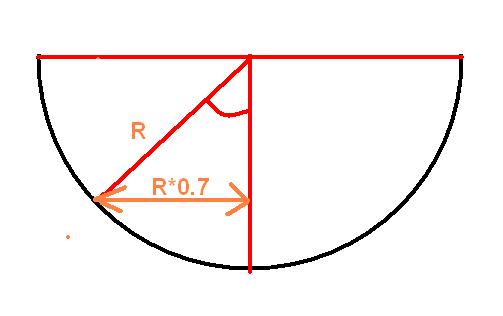 Not at all, for the span of the LM extends on each half of the visor on radius*sinus(45)= radius*0.7071. That means in fact the LM occupies more than the 7 tenths of the span of the visor, and the lunar ground is only visible on 3 tenths of it (even less). 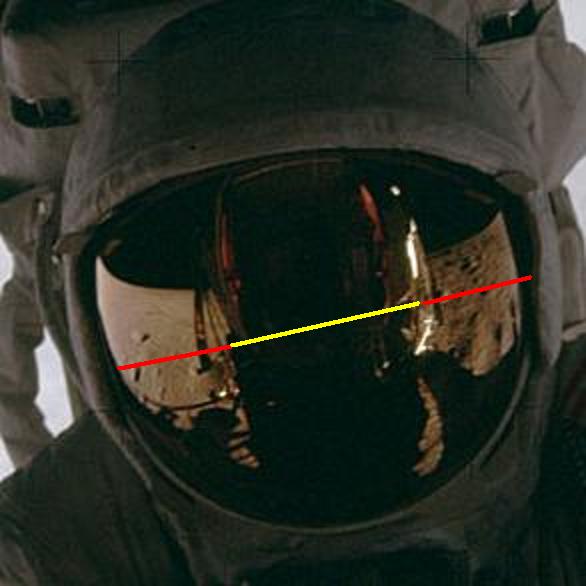 Yet, we see the lunar ground on a little more than half of the visor; we see too much of it. 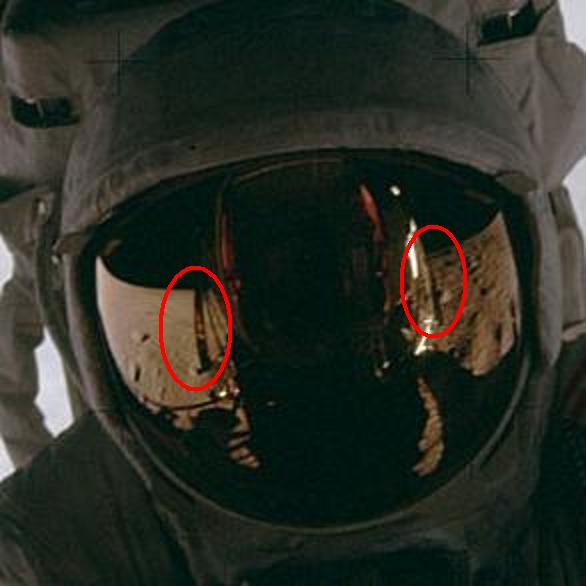 Then, if the legs I have circled in red are the legs of the LM, then they are placed too high. The legs are under the astronaut, not above him, and they should thence appear in the lower part of the visor, and not its upper part. 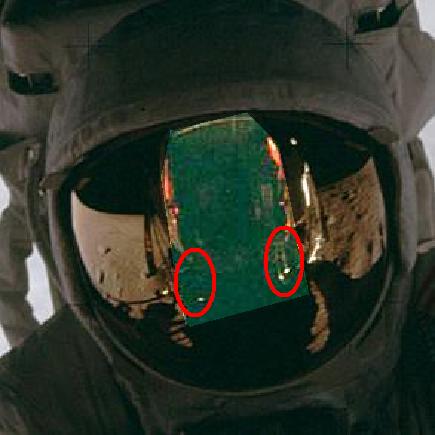 I have added luminosity on the part of the visor which appears dark. After having added luminosity, it appears green, but it's not because I have added green; I have only added luminosity, and it's the fact of adding luminosity which makes it appear green. It seems that we see the LM; we can see legs that I have circled in red; they are placed lower than the two other legs (but still incorrectly, for they are too close to the middle of the visor). 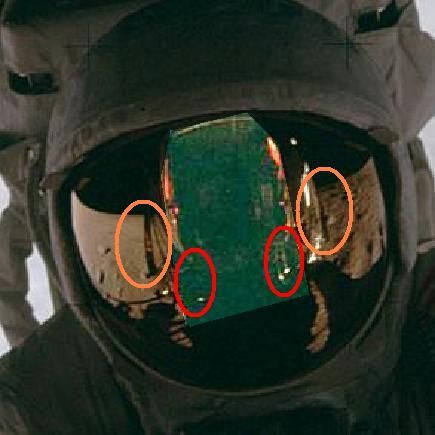 But if the legs I have circled in red are the legs of the LM, then what are the legs I have circled in orange? What is this strange flying saucer behind the LM?  Concerning the strange orange thing we see on the right of the photo (and which looks like a mask), it's an invention which does not really belong to the lem. |
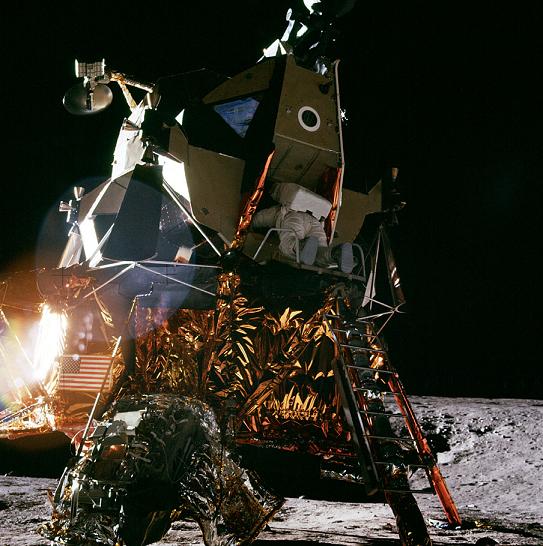 On this photo (AS12-46-6725), there is a strange alien's head lying on the ground. |
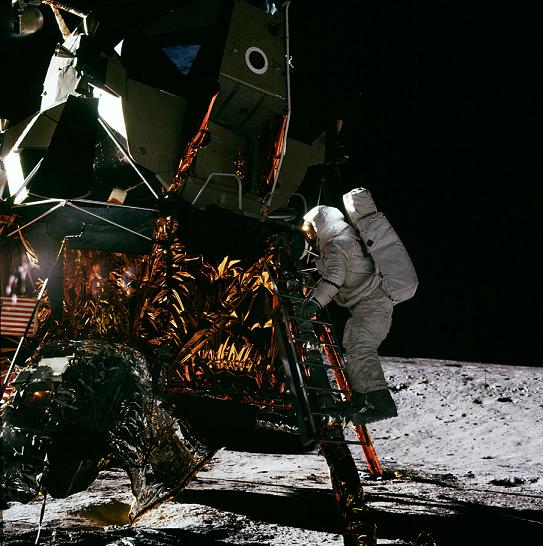 On this photo (AS12-46-6728), the alien's head is moving up. And the foot of the astronaut looks strange. |
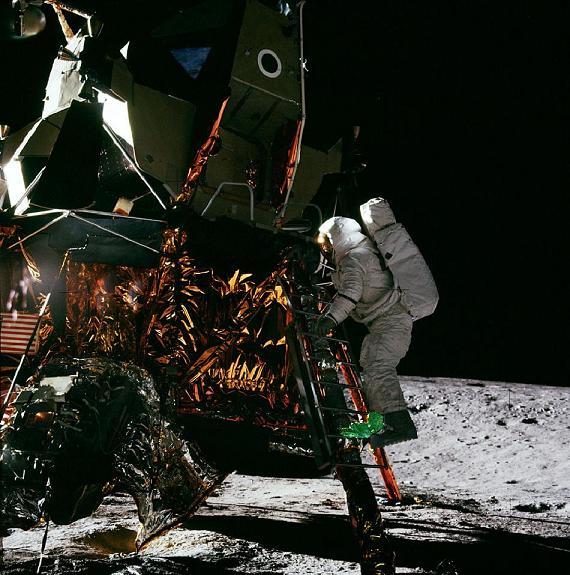 I have added luminosity to this foot, and we see a very strange thing appear. |
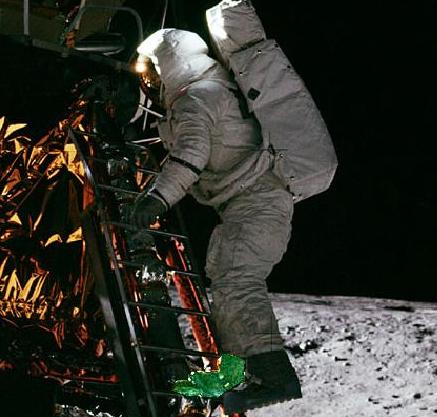 And here is a close-up on this most strange astronaut's foot (after I have added luminosity to it)! |
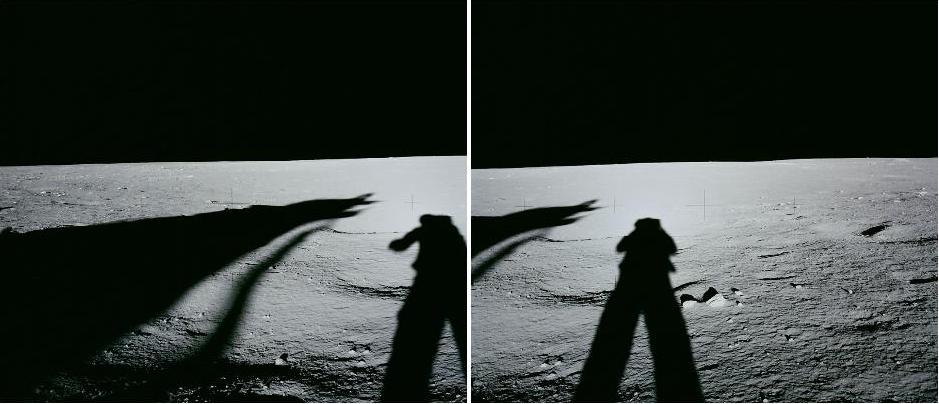 on the photos AS12-46-6730 and AS12-46-6731 the photographer takes a photograph of the lunar ground with the lem on his left, on the second photo he turns the camera on the right. On the first photo, he is correctly oriented, but he doesn't seem ready to take the photo. On the second photo, the photographer seems a little more concentrated on his camera. |
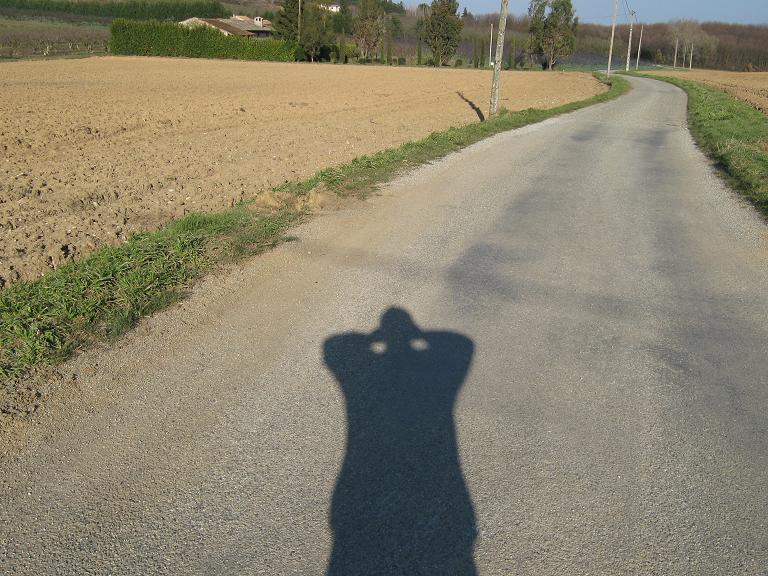 I am going to show a little demonstration about how the photographer's shadow appears on the photo according to the way he orients himself toward the sun. On this photo, I have the sun right in my back; consequently my shadow is on the middle of the photo and seen facing it, not in profile. I have well extended my arms so you can see my orientation.  On this second photo, I have turned my camera on the left (or counterclockwise around the vertical axis, more technically). The sun is now shining on my left; consequently my shadow has been pushed on the right of the photo, and I show a profile oriented on the left. 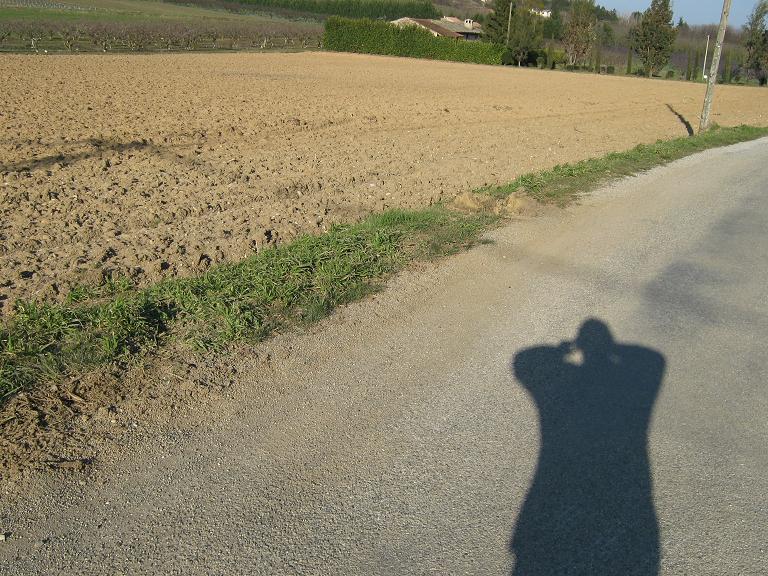 On this third photo, I have turned my camera on the right (or clockwise around the vertical axis, more technically). The sun is now shining on my right; consequently my shadow has been pushed on the left of the photo, and I show a profile oriented on the right. 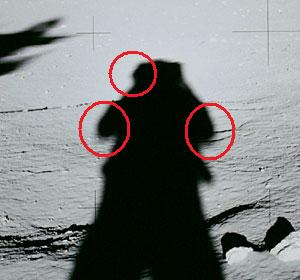 On the photo AS12-46-6731 the photographer's shadow is pushed on the left; this means he has sun on his right; he should be seen looking on the right, and he is seen looking on the left instead; on the earth, you could orient your camera with your hands differently from your body, but the astronauts couldn't do it as they had their camera strapped to their chest. |
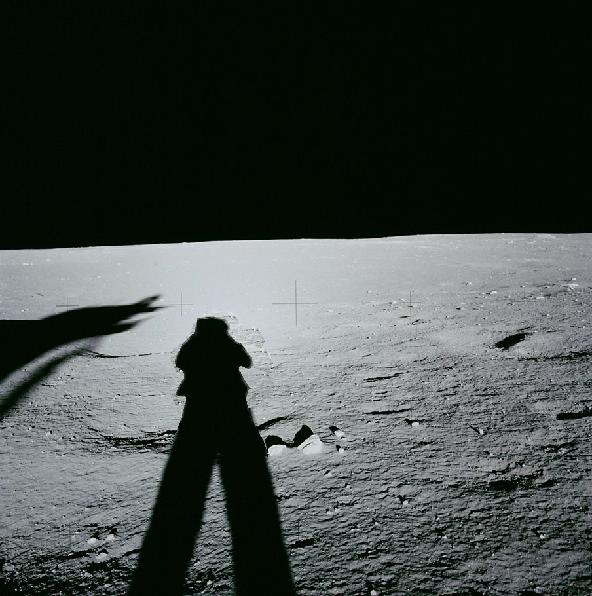 I'm representing here how the photographer's shadow should have looked like. |
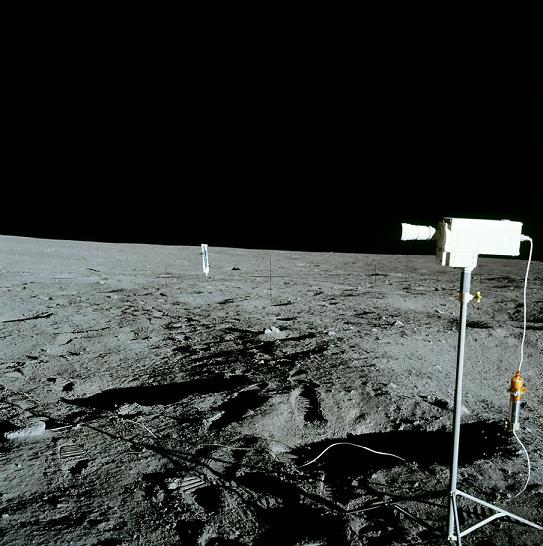 On this photo (AS12-46-6755), the solar wind collector looks rather strange. |
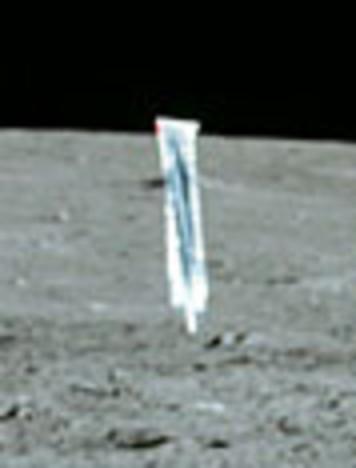 We see better with this close-up; there is a strange shape on this collector. |
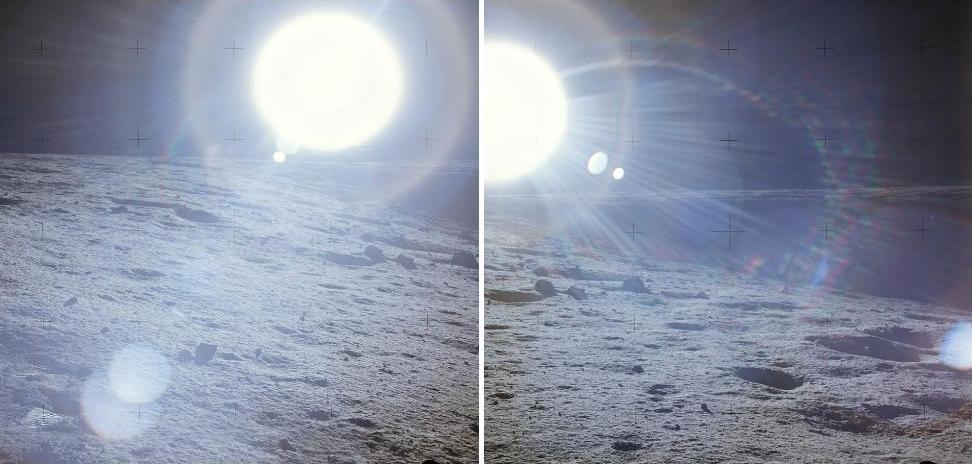 Here on the photos AS12-46-6767 and AS12-46-6768, the astronaut is near a crater and takes the sun which appears on the edge of the crater. On the second photo he turns his camera on the right, and the sun is pushed on the left of the photo. Apparently, nothing abnormal. 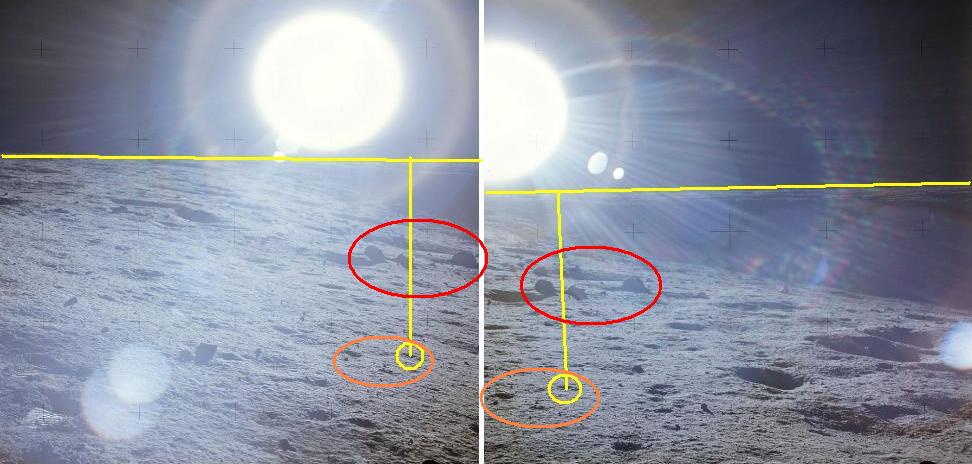 On these photos we can see two things: - A triangle of stones I have circled in red. - And a triangle of holes I have circled in orange. We can see that the triangle of holes has slightly moved on the left relatively to the crater's edge (and also the triangle of stones), and that it's also a little farther. Consequently, the photographer has moved on the right and back between the two photos, moreover turning his camera.  In order to make the holes more visible, I have colored them with different colors on the two photos (red, green and blue). 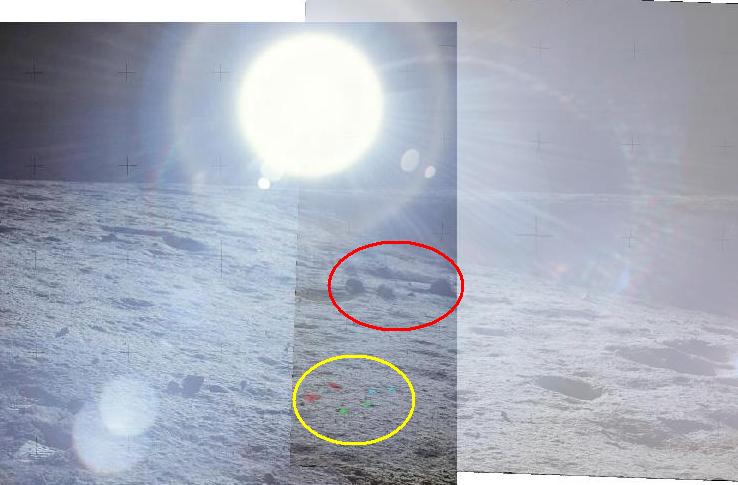 Then, I make a superposition of the two photos with the colored holes, so that the crater's edges are as perfectly superposed as possible (i.e. I correct the orientation of the second photo to give it the same orientation as the first photo, and I put the second photo in the continuity of the first one). And what can we see on this superposition? We can see two replicas of the triangle of holes (the colored points). We should also see two replicas of the triangle of stones which is also closer to the photographer than the crater's edge. These two replicas would be closer to each other than the two replicas of the triangle of holes, but we should still see them, and we don't: The two triangles of stones are perfectly superposed. |
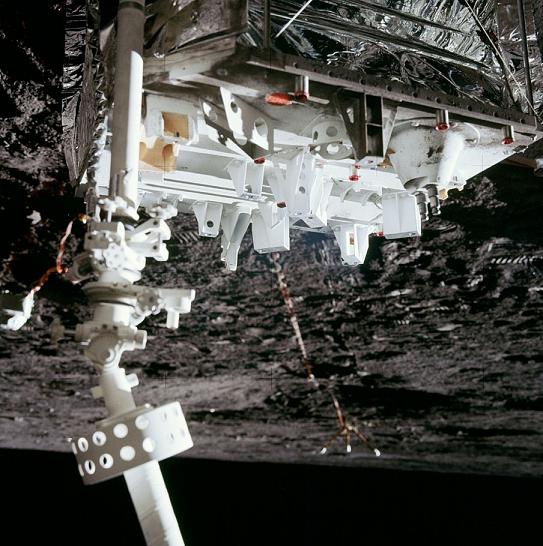 This photo is taken upside down. Knowing that the astronauts had their camera strapped on their chests, in order to take this photo, the astronaut would have had to walk on his hands; in this position, triggering the camera would have been rather difficult! |
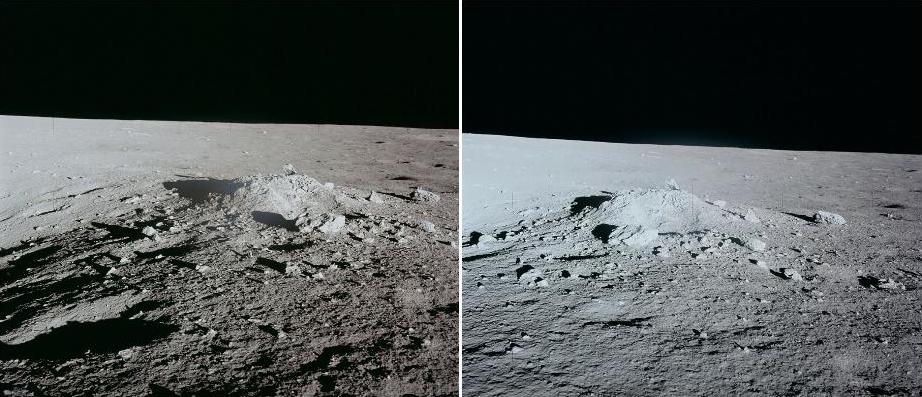 On this couple of photos (AS12-46-6822 and AS12-46-6823), the camera turns around a little mound between the two photos. 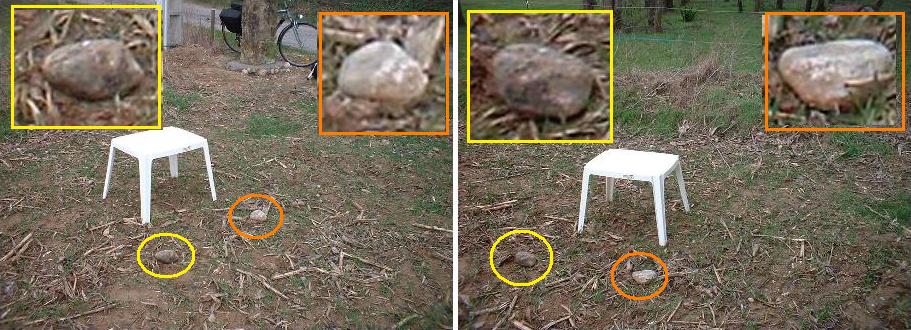 I have taken two views of a little table with two stones just before. The table represents the little mound, and my stones the stones which are near the little mound. I turn around the table like the photographer turns around the little mound on the Apollo photos. In windows on the top of the photos I show how the stones appear on each of the photos. And we can see that the way the stones appear changes completely between the two photos. 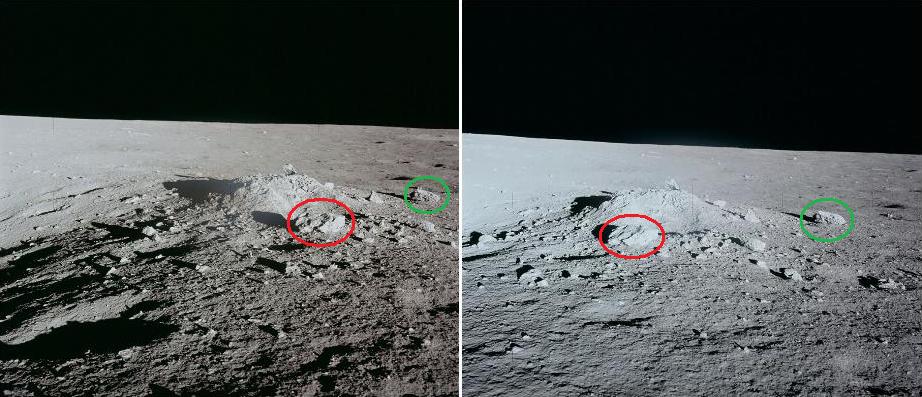 On the Apollo photo, the two stones I have circled refuse to rotate, and show almost the same profile on the two photos. 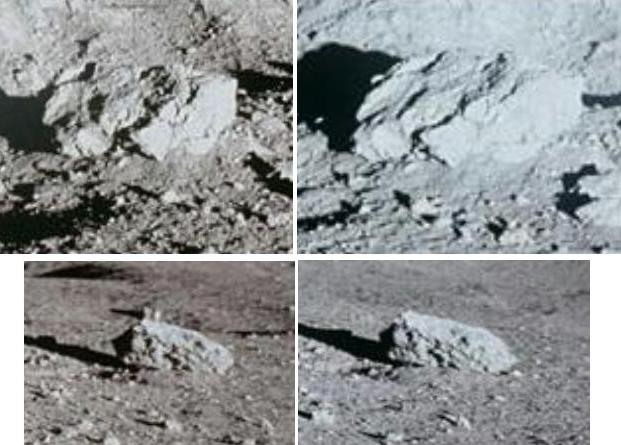 On this photo, I show each of these stones before and after the rotation of the scene. |
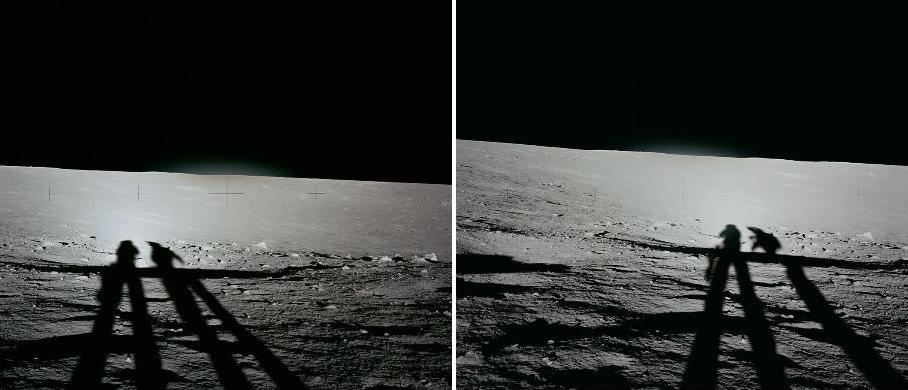 On these two photos (AS12-46-6841 and AS12-46-6842), the photographer takes a photo with the other astronaut on his right. On the second photo he turns the camera on his left; consequently the shadows of the astronauts are pushed on the right of the photo. We can see that the photographer is the astronaut on the left because he has the correct orientation on the two photos. In what concerns the other astronaut, he is so much in profile on the second photo that his legs make just one; he probably preferred to look at his comrade rather than at the lunar view. |
To show what's wrong with these two photos, I'm going to show you a real demonstration. 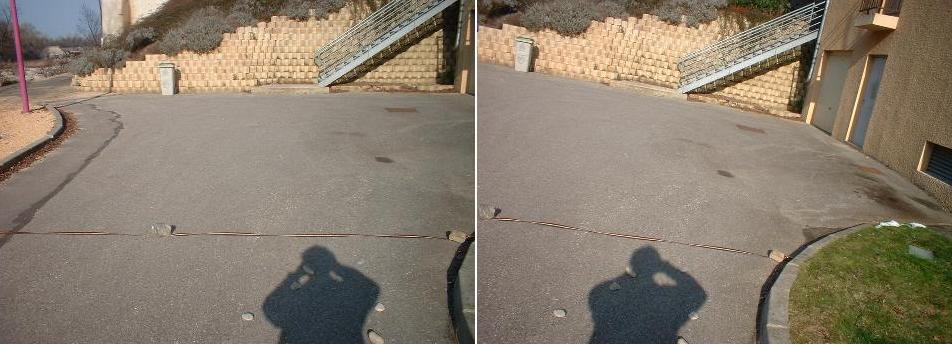 On this first double view, I have remained at the same place (I have put stones around my shadow to show it doesn't move), and I have turned my camera in the two directions. I have stretched a ribbon supposed to represent the foreground. The wall in the back will represent the background. 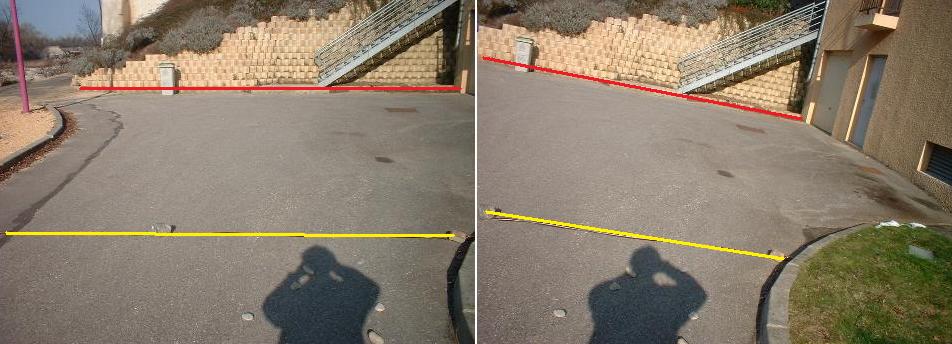 On this double view we can see that the foreground (yellow line) and the background (red line) rotate the same; the foreground does not rotate relatively to the background. My shadow has been pushed on the left because I have turned my camera on the right. When you turn your camera around the vertical axis, the foreground does not turn relatively to the background, and both show almost no rotation. When you bend your camera, all things rotate the same way (i.e. the foreground rotates the same way as the background, and therefore does not rotate relatively to the background). 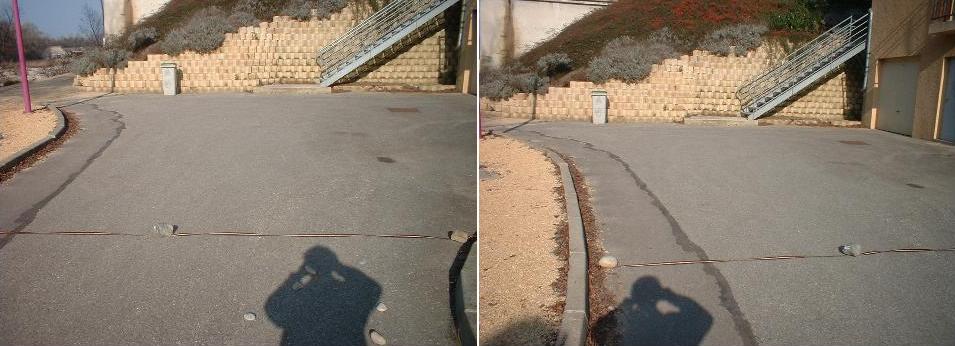 On this new double view, I have moved on the left between the first and the second photo. 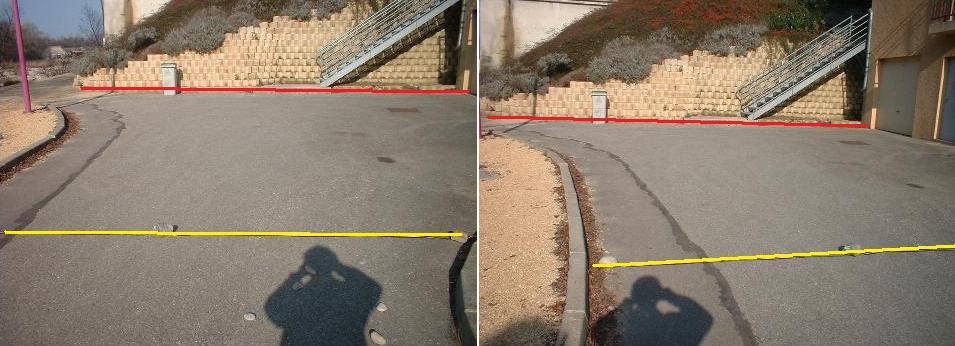 And this time we can see that the foreground shows a rotation relatively to the background. 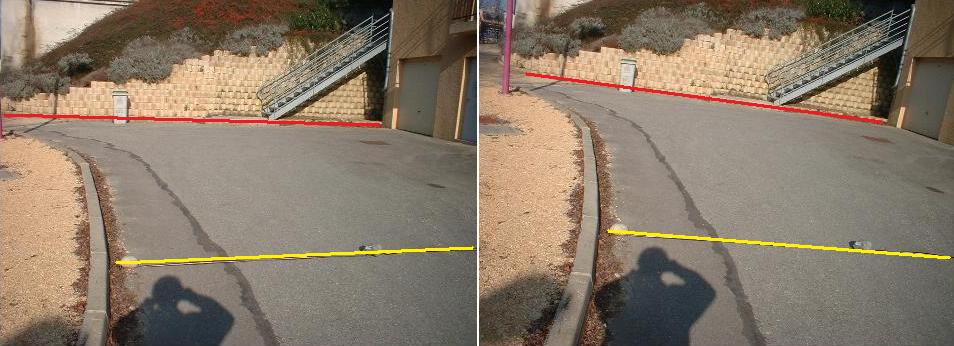 If, from this second position, I turn my camera, the foreground and the background both rotate the same way. 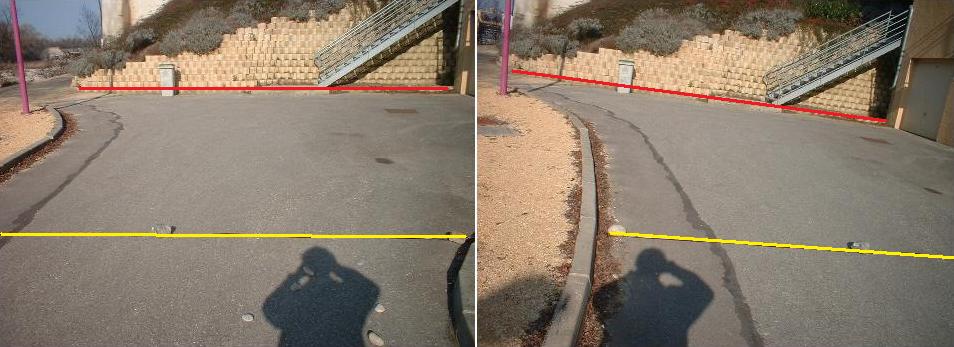 If we compare the photo at the first position of the photographer with the photo at the second position of the photographer with the camera rotated, the foreground still shows a rotation relatively to the background, but this only comes from the move of the photographer, and not from the rotation of the camera.  So the conclusion of this demonstration is that the foreground can only rotate relatively to the background if the photographer moves and not if he turns his camera. 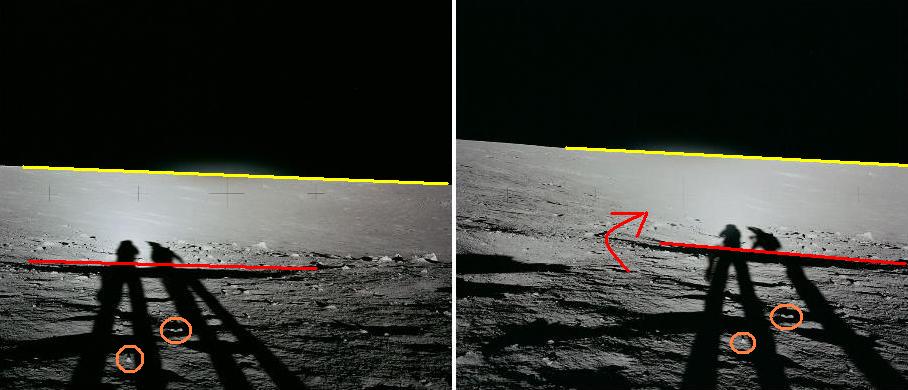 So now we can better see what's wrong with these two photos: We can see the same rocks near the photographer's shadow on the two photos; conclusion: the photographer has not moved between the two photos. We can also see that the foreground has made a little (clockwise) rotation relatively to the background; conclusion: the photographer has moved between the two photos (because it can only happen if he moves and not if he turns his camera). So this demonstration of the fakers shows that the photographer both moves and doesn't move! |
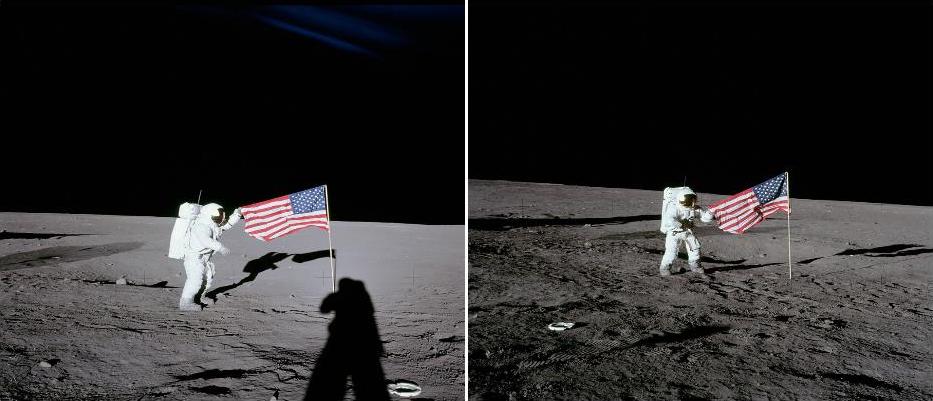 On this couple of photos (AS12-47-6896 and AS12-47-6897), we can see that the scene has rotated between the two photos. |
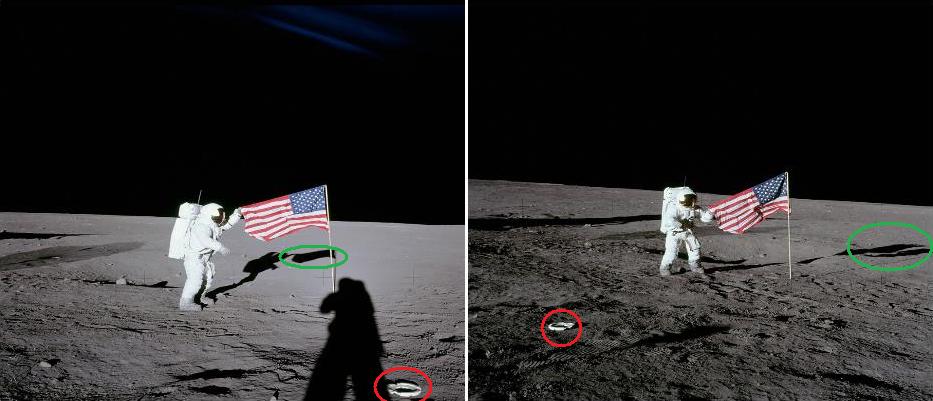 We can effectively see that a white object (I have circled in red), and the shadow (I have circled in green) have both rotated. But the flag itself has not! It's a flag which refuses to rotate. And there will be other occasions in which it will also refuse to rotate. It must be a flag which is afraid of rotating; rotating must make it dizzy. |
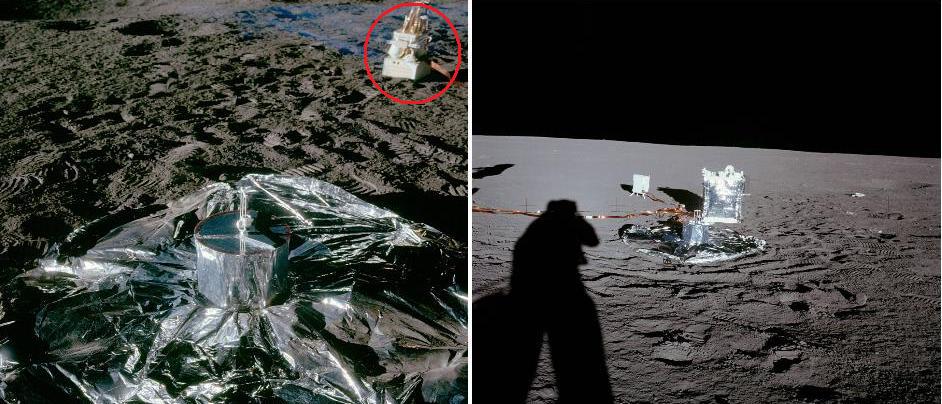 On the photo AS12-47-6916 (of which here is a close-up) there is an object (I have circled in red) which is not present on the photo AS12-47-8918. |
 On photo AS12-47-6981 there is a weird object which is on the top platform and which is not present on AS12-47-6989. |
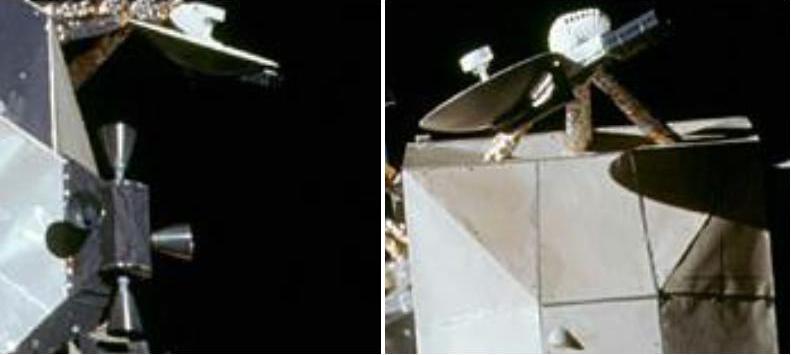 On this close-up, we can see this strange object. |
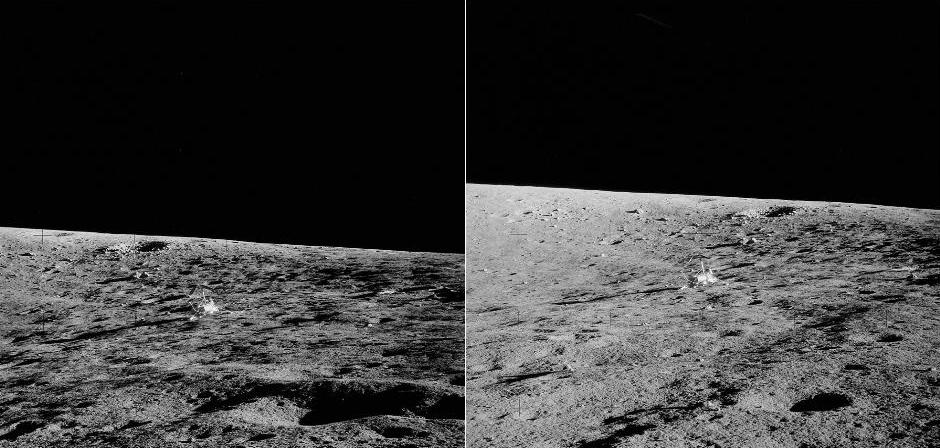 Between these two photos (AS12-48-7087 and AS12-48-7088), there has been an important rotation of the scene. 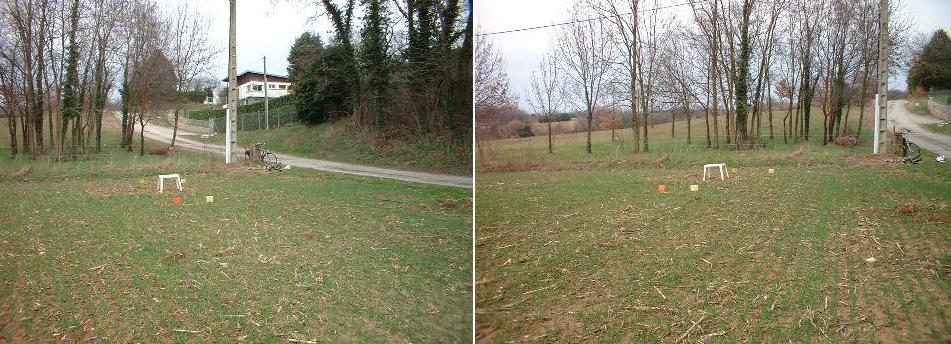 On this double view I show two views of a little table with colored boxes before and after. Between the two views I have moved on the right. The position of the colored boxes relatively to each other and to the table has changed, but the orientation of the table has also changed. 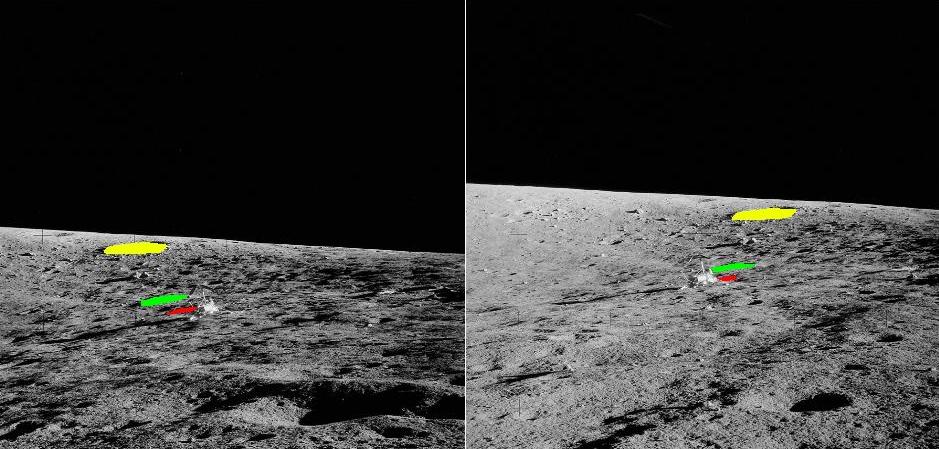 I have colored with corresponding colors holes we can see on the two photos, and the direction of these holes has substantially changed between the two photos. Consequently the orientation of Surveyor should have consistently changed, but it doesn't appear to have changed.  If we zoom on surveyor on the two photos, we can see that the rotation of Surveyor is insignificant, far from the consistent rotation it should show. I think we can call this an incoherence! |
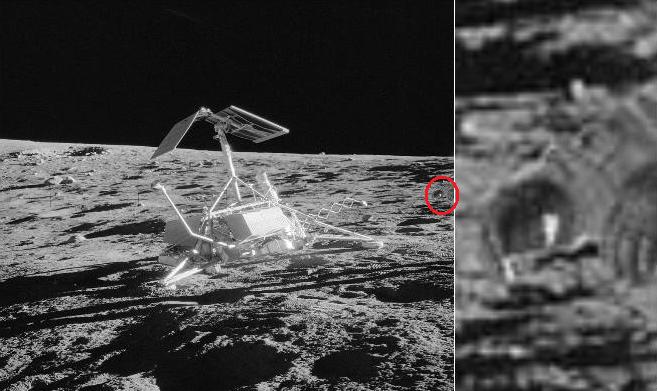 On the extreme right side of the photo AS12-48-7121, we can see a strange animal; I guess it's a lunar dog! |
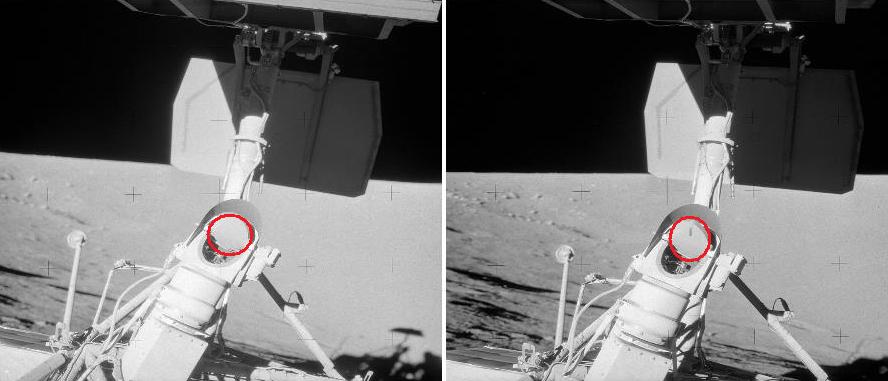 On the photo AS12-48-7131, there is a line which is missing on the photo AS12-48-7130. |
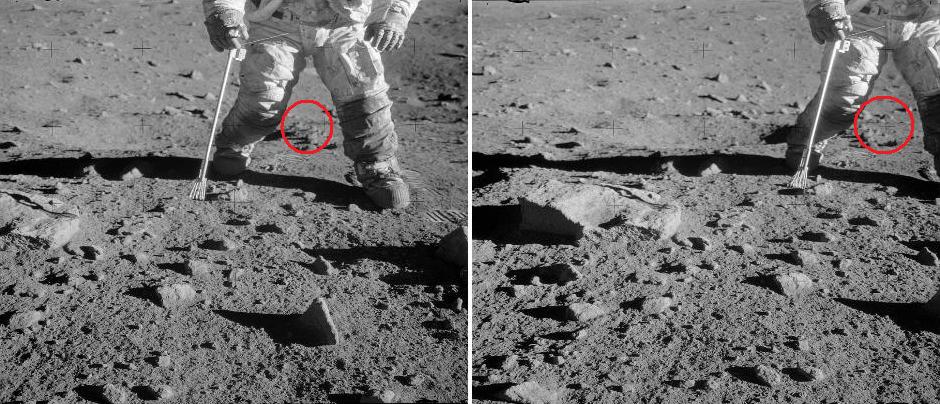 Between the legs of the astronaut there are little rocks which are present on photo AS12-48-7150 and absent on photo AS12-48-7149 in the zone that I have circled in red. |
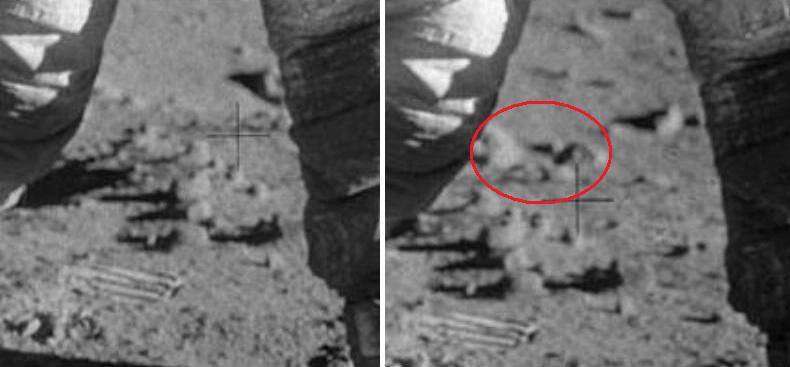 On this close-up, I have circled in red the rocks which are present on the second photo and not the first one. |
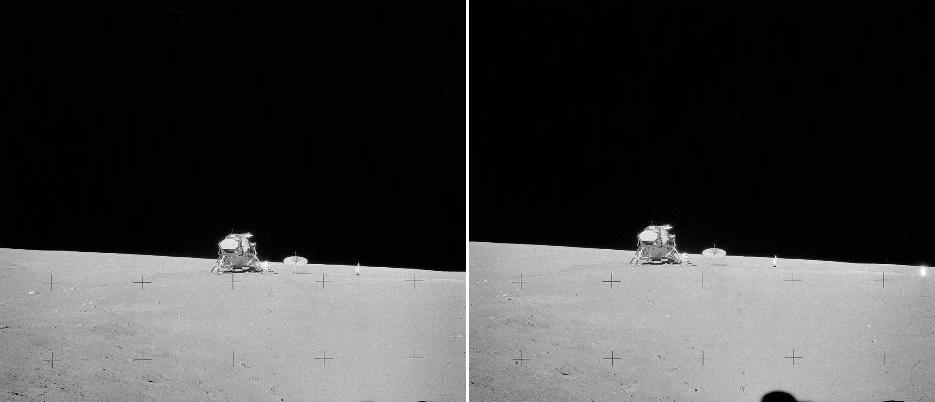 On photos AS12-48-7151 and AS12-48-7152, the photographer takes the lem in the distance. On the second photo the top of his shadow appears, and it's normal, for he has turned his camera down (and also on the right), it's visible for the horizon line is higher on the second photo than it is on the first one. 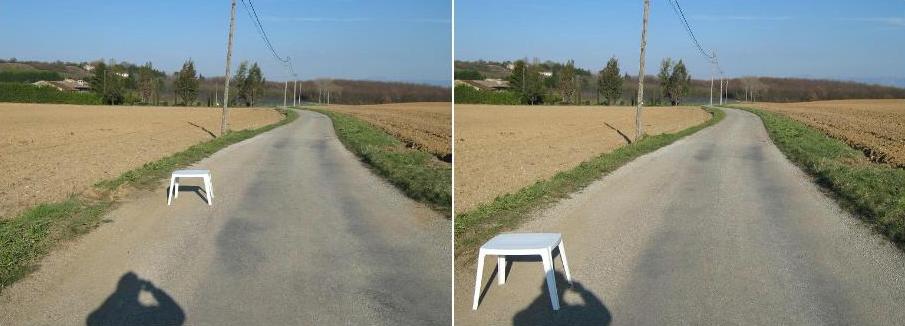 The photographer's shadow shares a common property with the horizon line: It only moves vertically on the photo if the photographer turns his camera (around the horizontal axis), and not if he moves forward (or backward), and it moves the same way as the horizon line. 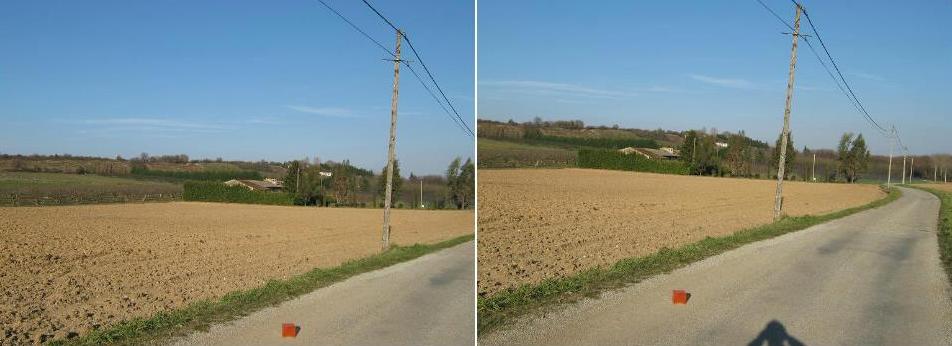 On this double view, on the first photo the shadow of my head is not visible; on the second photo, it appears, but the horizon line has moved up of the same height as the one of my head's shadow.  I have made measurements on print copies of the photos; I have found that the two extremities of the horizon line have moved up of two millimeters; as the photographer's head's shadow was not at all visible on the first photo, at most 2 millimeters of it should appear on the second photo, in the best of cases; and yet it appears on 5 millimeters; it means that the photographer's shadow has more moved up than the horizon line, when it should have moved up the same. 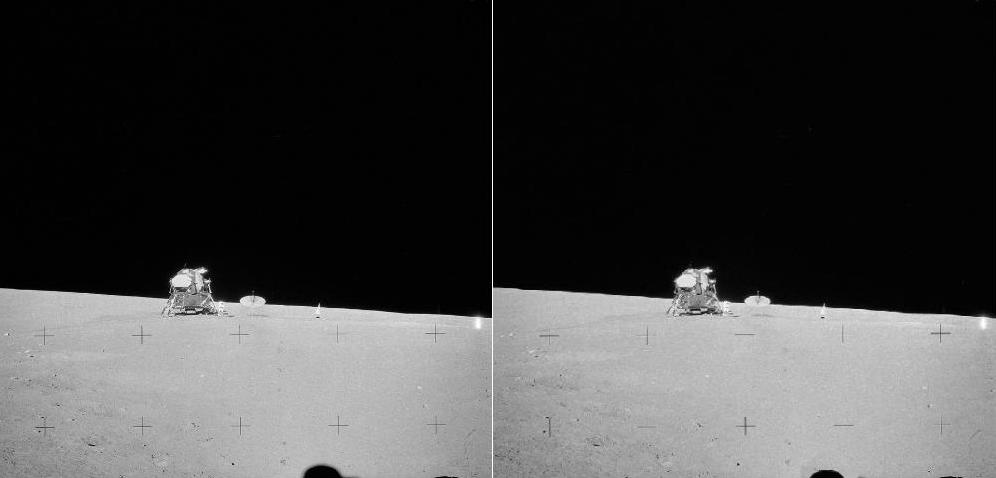 On this double view, I show on the left the original second photo, and on the right the same photo I modified to show the part of the head's shadow which should normally have appeared (i.e. only two millimeters of it instead of 5 millimeters). |
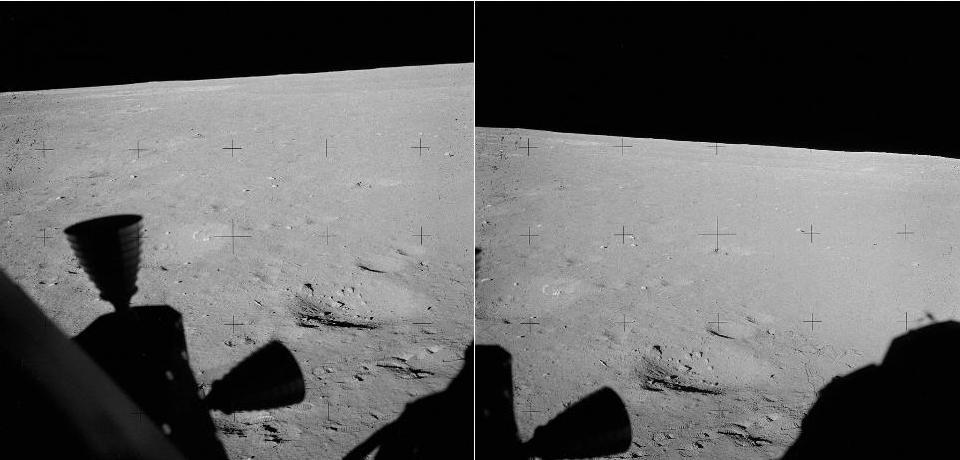 On these two photos AS12-48-7153 and AS12-48-7154, the photographer takes a photograph from the lem, with the lateral thrusters in the immediate foreground, and lunar holes farther. On the second photo the photographer turns his camera on the right. |
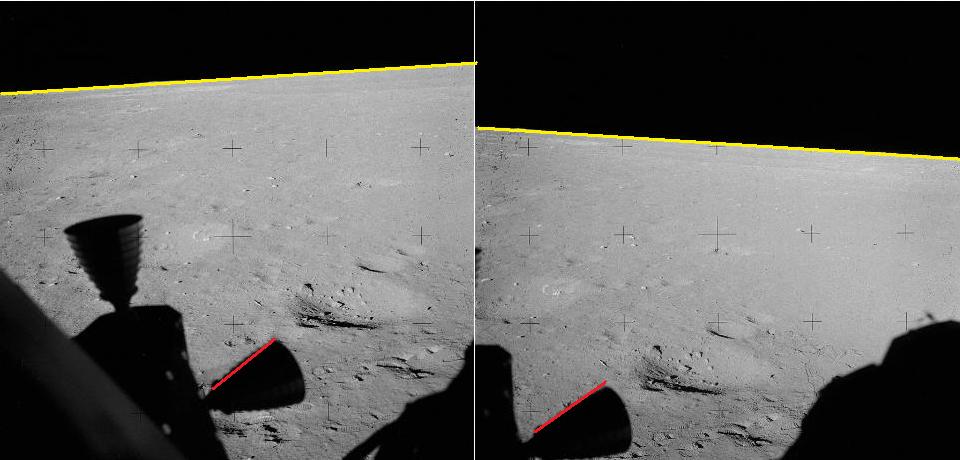 We can see that the position of the lateral thruster relatively to the holes is the same on the two photos; this means the photographer has made no lateral move. There is a little vertical move of the thruster which shows that the camera has been a little lowered between the two shots, but this move tends to make the thruster turn clockwise. 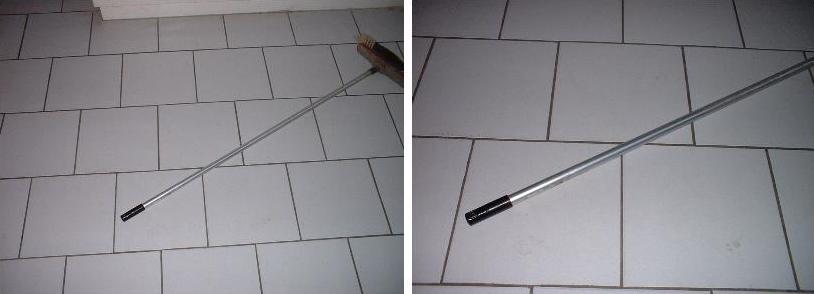 In order to show it to you, I show you a little demonstration, in which I orient a broomstick like the indicated edge of the thruster, and I take two shots, one from up, and one after bending down ; when I bend down, we can see a slight rotation of the broomstick clockwise (with the same orientation of the cameral). As the orientation of the indicated edge of the thruster has not changed between the two photos (by counter rotating the camera), the horizon line should have slightly rotated counterclockwise between the two photos, but it’s not the case: It has made an important clockwise rotation instead! On example more of foreground and background rotating contradictorily. |
On this animation we can clearly see the difference of movement between the foreground and the background: Look up and you see a rotation, look down and you see none! |
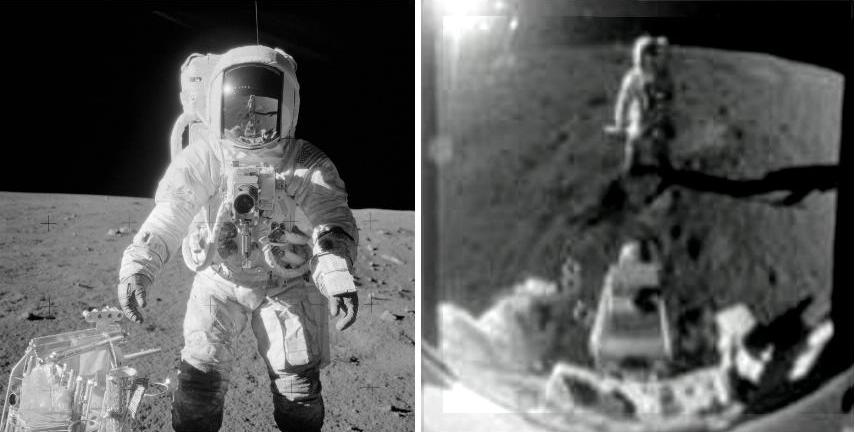 On the photo AS12-49-7281, we can see the reflection of the camera in the visor. |
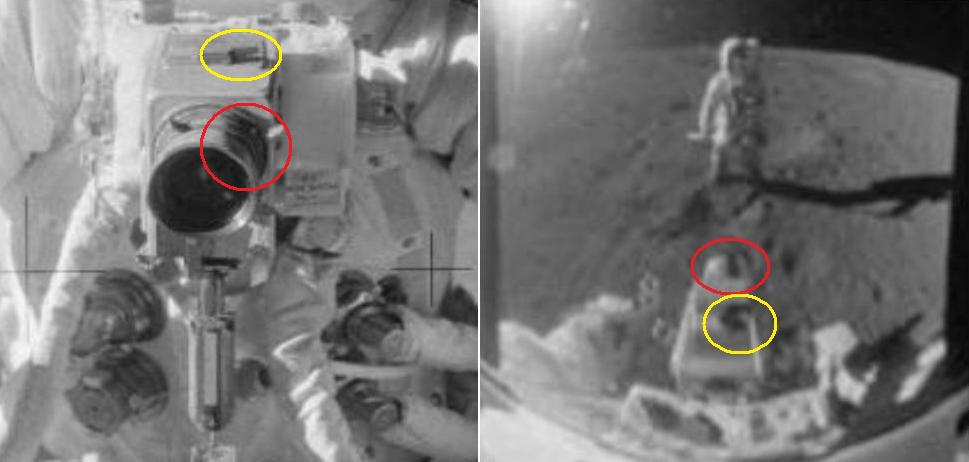 There are several anomalies on this reflection. First, as we see the shadow of the photographer oriented on the right in the visor, the objective (circled in red) should also be shaded on the right. There is effectively a black strip on the right of the objective, but on the right of this black strip, the objective is brilliant again! The part of the body of the camera I have circled in yellow is different from the real camera. |
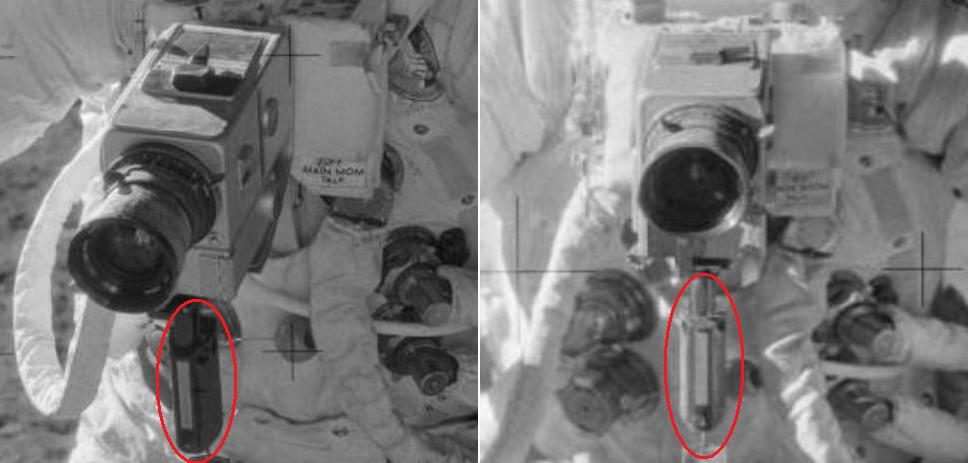 The cameras we see on the photos AS12-49-7278 and AS12-49-7281 are not the same; in particular the handles (circled in red) are not the same. |
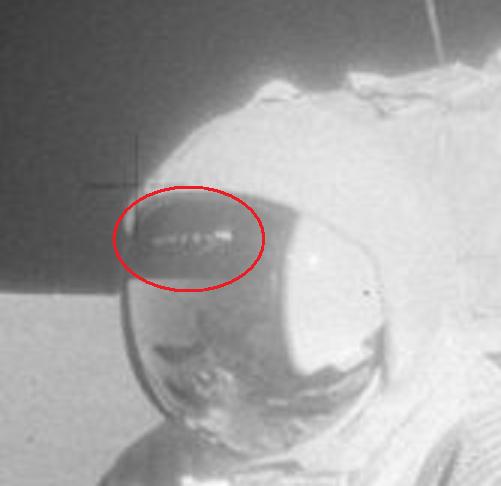 In the photo AS12-49-7307, there is a strange reflection on the top of the visor; I really wonder what it could be the reflection of! |
 On photo AS12-49-7308, a strange object masks the shadow of the astronaut, and it's not part of the lab table. |
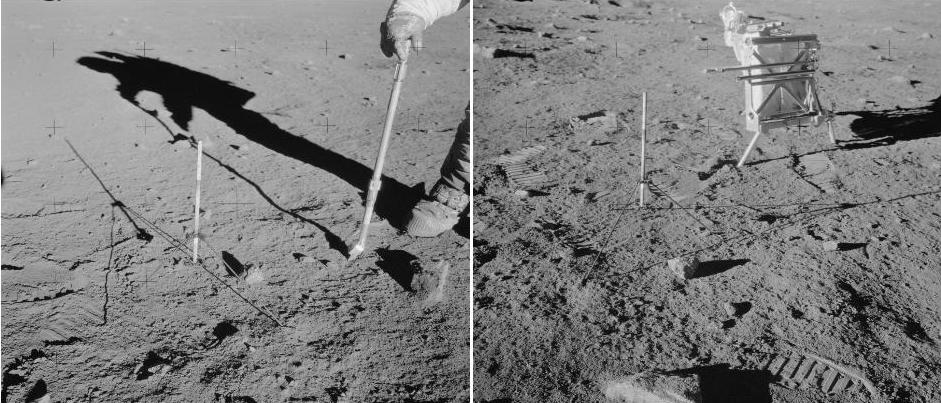 On photos AS12-49-7313 and AS12-49-7315, we have two views of the tripod; two of the legs have shadows which are close to each other, and the third leg has a shadow which is farther from the shadows of the two others. |
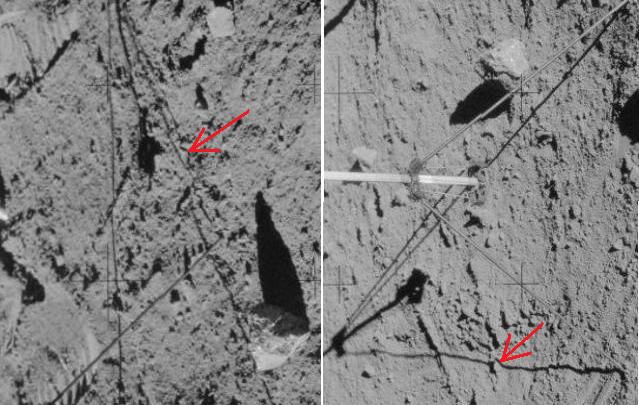 But if we look closer at the shadows of the legs of the tripod, we can see that, on each of the photos, there is a leg's shadow (I show with a red arrow) which is tortuous and the two other ones are straight...the problem is that on one photo it's one of the shadows which are close to each other which is tortuous, and on the other photo it's the shadow which is farther from the two other ones which is tortuous! Very well imagined from the facetious fakers! |
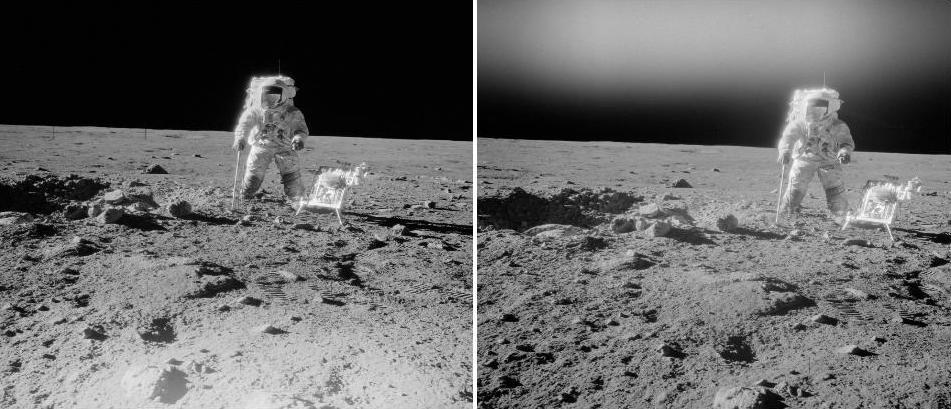 On this couple of photos (AS12-49-7318 and AS12-49-7319), on the first one it's the foreground which is haloed by a strange bright light, and on the second one it's the sky! The holy spirit is successively blessing the lunar ground, then the lunar sky! |
 On photo AS12-46-6751, the shadow of the flag obviously does not correspond with the flag itself; on the photo, the flag's cloth is falling lower, closer to the flag's foot, than on the shadow, even if we take into account the perspective. If we takes as a reference the shadow of the flagpole, the projections show that the cloth's shadow cannot be correct: 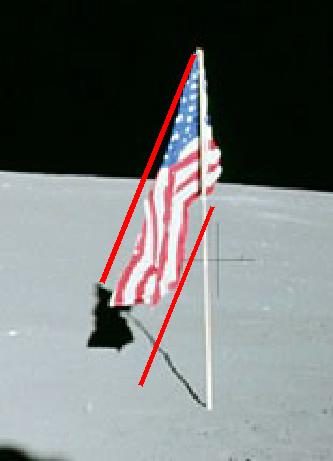 |
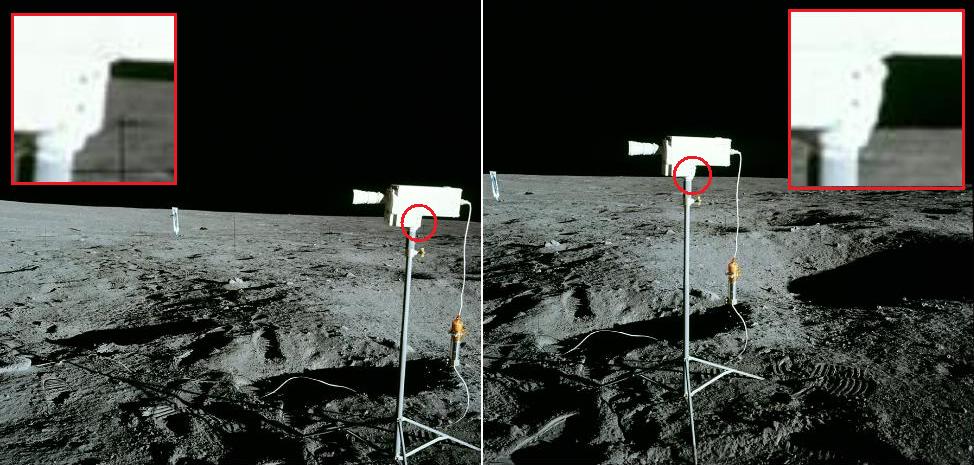 Photos AS12-46-6755 and AS12-46-6756 show two views of a camera mounted on a tripod. If we look attentively at the camera, we can see that its handle is not exactly the same on the two photos, there is a detail changing. I show a close-up of this handle in a window on each photo. |
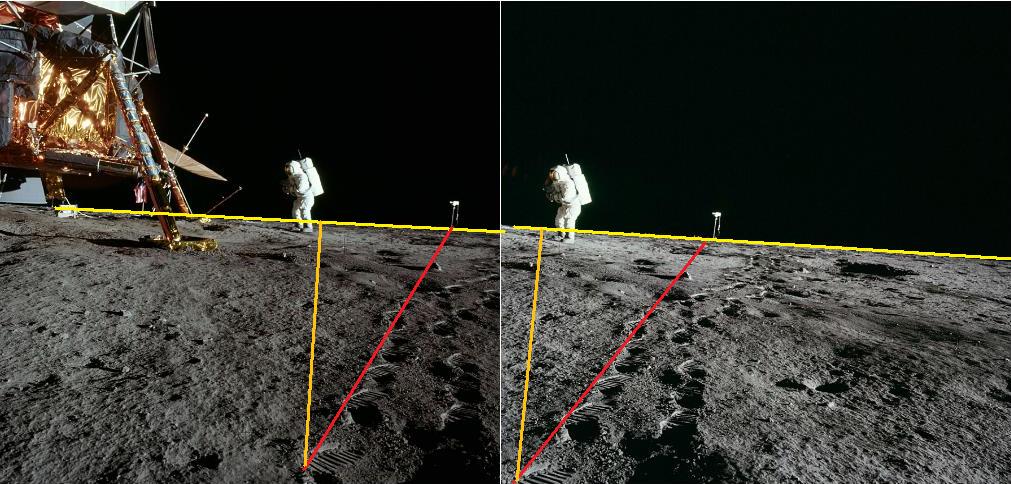 On photos AS12-46-6779 and AS12-46-6780 we see a path of footprints; between the two photos the photographer has made a little move, no more than a step, and yet the angle that the path makes with the horizon line varies importantly. |
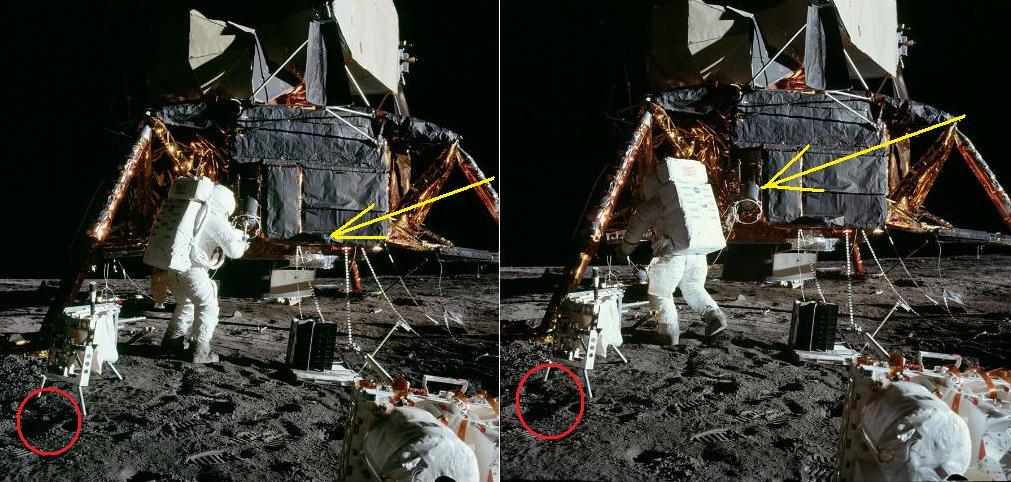 On photos AS12-46-6787 and AS12-46-6788 we can clearly see where the sunlight comes from, because on one photo the backpack of the astronaut is in the shadow, and on the next photo, when he turns it in direction of the sunlight, it's brightly lit. It's thence obvious that the shadow of the device on the extreme left is incorrectly oriented. |
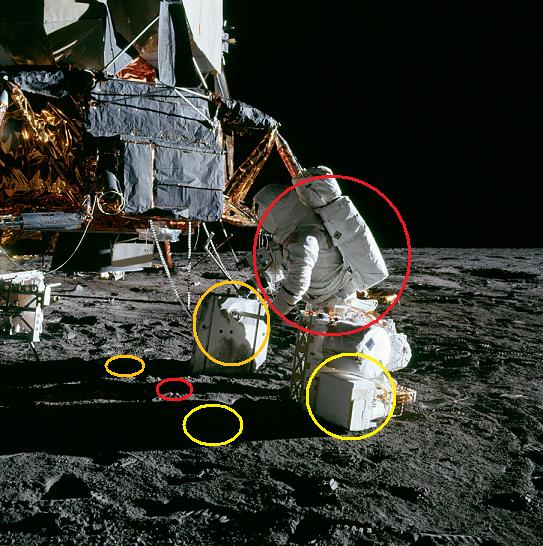 On photo AS12-46-6792 we see the astronaut and two devices on each side of him; his shadow is also between the shadows of the two devices; the problem is that the astronaut has a shadow which is much too thin compared with the shadows of the devices; his shadow is thinner than the one of the device he has on his right and yet he is larger than this device! |
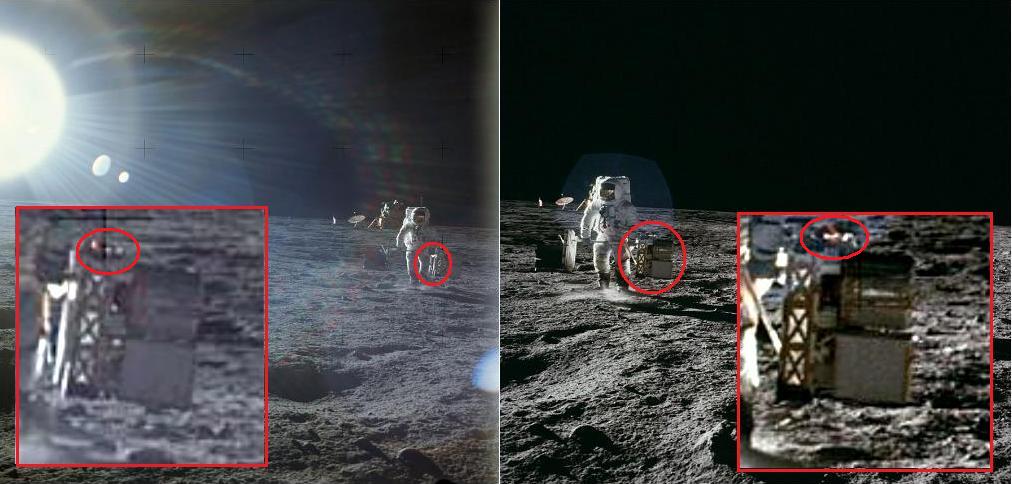 On photos AS12-46-6806 and AS12-46-6807 there is an alien thing on top of the device the astronaut is carrying which is different; it looks weird, like a cartoon character, but what's sure is that it changes from one photo to the other one. |
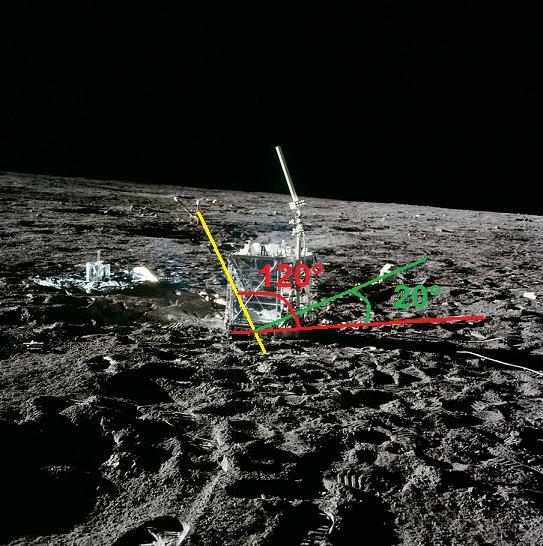 On photos AS12-46-6817, AS12-46-6816 and AS12-46-6815, we have three views of the ALSEP with three ribbons stretching behind. On photo AS12-46-6817 we have a view taken obliquely from far. The angle between the two extreme ribbons is approximately 120°, and, because the photo is taken obliquely, the angle between the middle ribbon and the leftmost one is greater than the angle between the middle ribbon and the rightmost one. 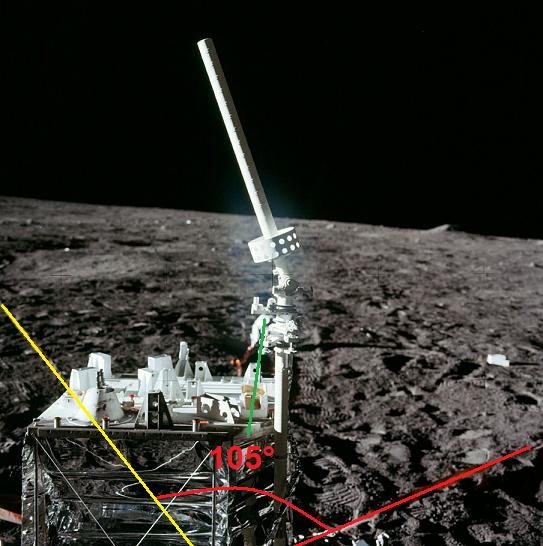 On photo AS12-46-6816, the photographer has gone closer to the ALSEP and is now facing it; the angle between the ribbons has been reduced in reason of the fact that the astronaut has come closer; the angle between the two extreme ribbons is now approximately 105°; the angle between the middle ribbon and the two other ribbons is almost the same in reason of the fact that the photographer is facing the ALSEP instead of taking it obliquely. 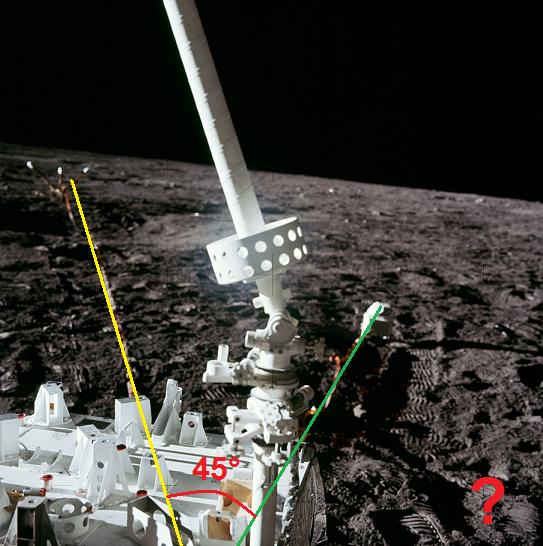 On photo AS12-46-6815, the photographer has gone still closer to the ALSEP, and obliquely again; the angle between the ribbons is still reduced since the photographer has gone closer to them. The angle between the middle ribbon and the rightmost ribbon is smaller again than the angle between the middle ribbon and the leftmost ribbon, and the latter is approximately 45°; it means that the angle that the middle ribbon makes with the rightmost ribbon is logically less than 45°: With a such angle we should see the rightmost ribbon on the photo and we don't see it! |
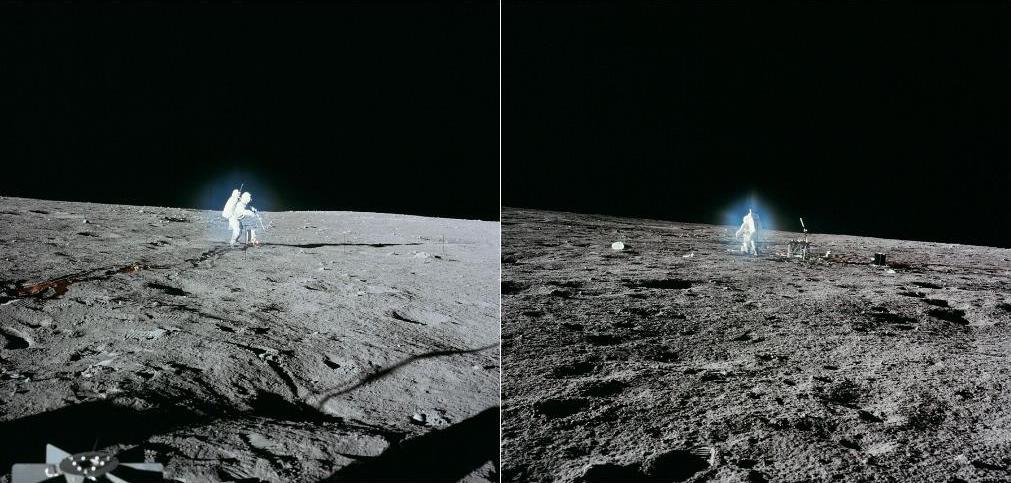 On photos AS12-46-6818 and AS12-46-6826 we can see blue halo around the astronaut. There could be a blue reflection on the photo at a given moment, but on the two photos this blue reflection is centered on the astronaut; it could be centered on the astronaut just per chance once, but twice, is it still chance?!? |
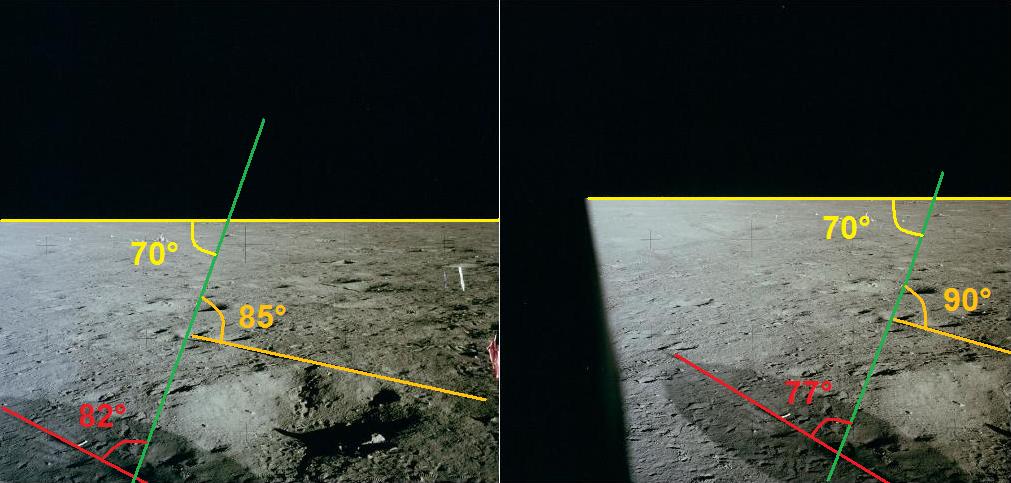 On photos AS12-46-6857 and AS12-46-6858, if we draw a (green) line along a row of holes, this line doesn't rotate relatively to the horizon line; but the shadows of the flag and the umbrella antenna both rotate of 5° relatively to this horizon line. |
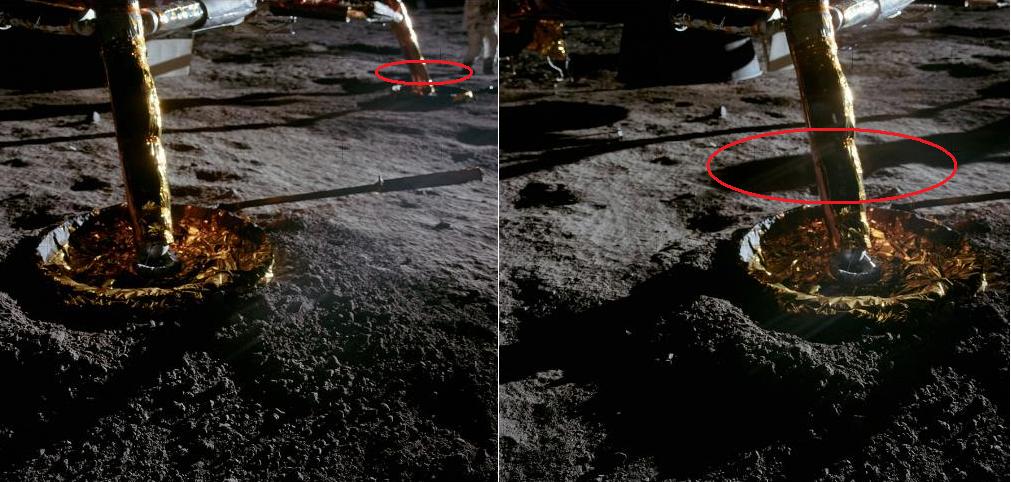 On photo AS12-47-6900 we see the astronaut and his shadow; on photo AS12-47-6901, we suddenly see a shadow appear (I circled in red), but it doesn't have the shape of the astronaut's shadow, and is also broader than the normal astronaut's shadow. |
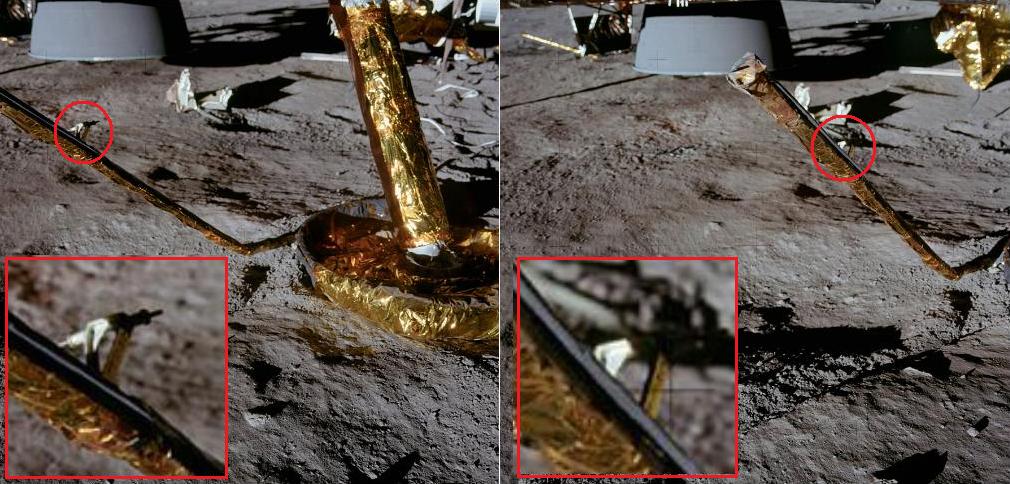 On photos AS12-47-6906 and AS12-47-6907, there is something strange on the footpad and different on the two photos. |
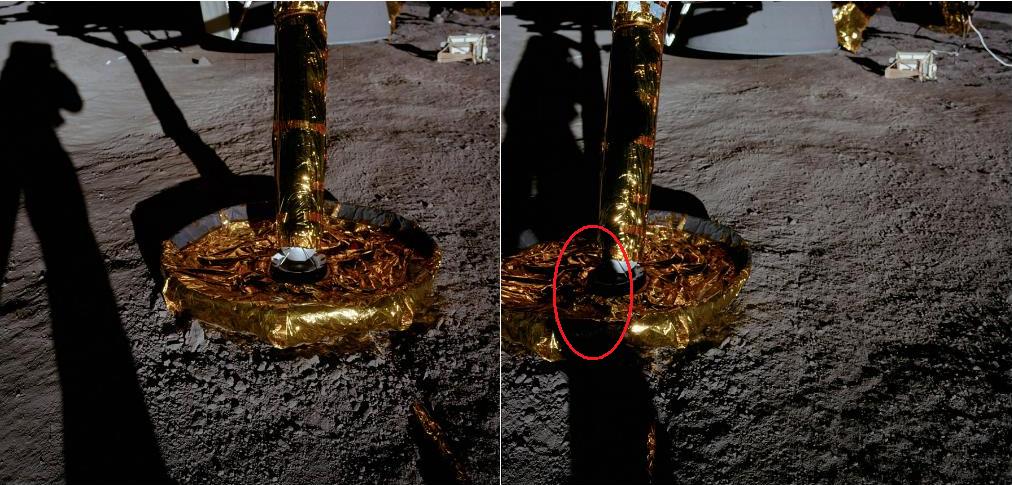 On photo AS12-47-6909 we see the astronaut beside a lem's foot; on photo AS12-47-6908 his shadow crosses the foot, but what's weird is that his shadow doesn't manage to cover this foot which remains brilliant. |
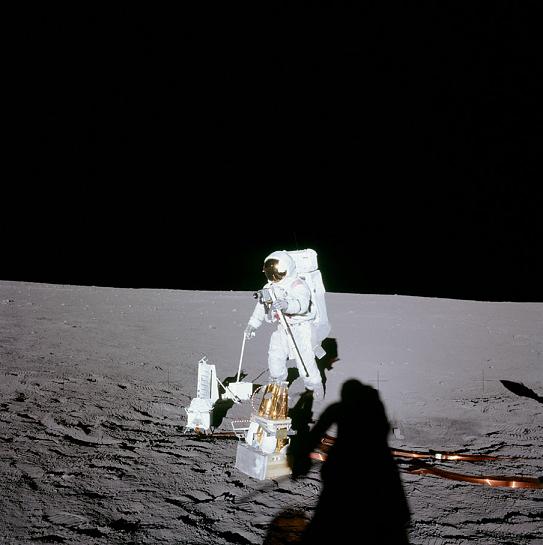 On photo AS12-47-6919, the way the shadow of the photographer looks, it would be surprising if he could take the photo! 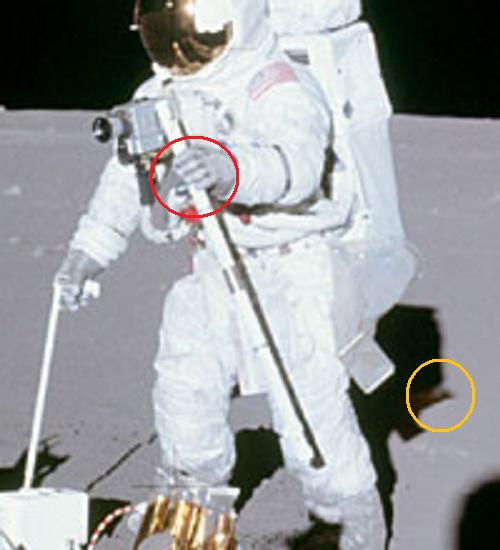 There's even better: Look how the astronaut is holding a stick in his left hand (I have circled it in red). The way he is holding it, we shouldn't see the shadow of the upper extremity of the stick...and yet we can see it (circled in orange)! |
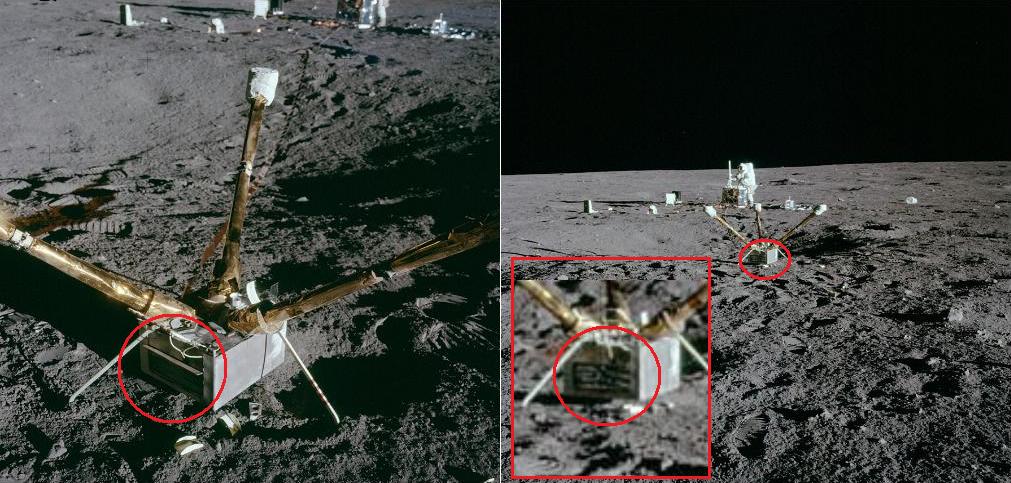 On photos AS12-47-6920 and AS12-47-6921 the magnetometer looks obviously different on the part I circled. |
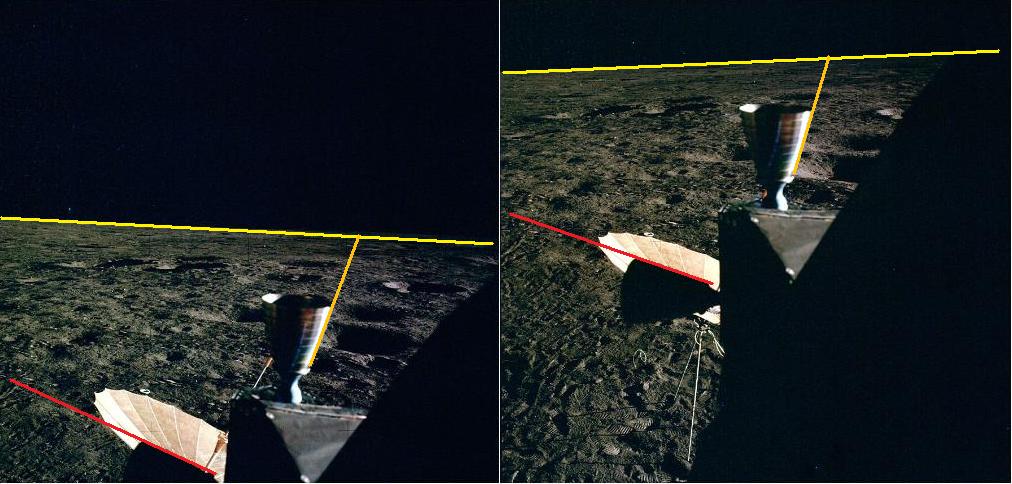 On photos AS12-47-7016 and AS12-47-7017 the photographer takes a photo from the lem with the lateral thrusters in the close foreground; we can see that the thrusters have moved on the left relatively to the holes on the ground which means that the photographer has moved on the right; consequently the vertical thruster should have rotated counterclockwise and the horizontal thruster clockwise relatively to the horizon line, but both have rotated in the opposite direction! |
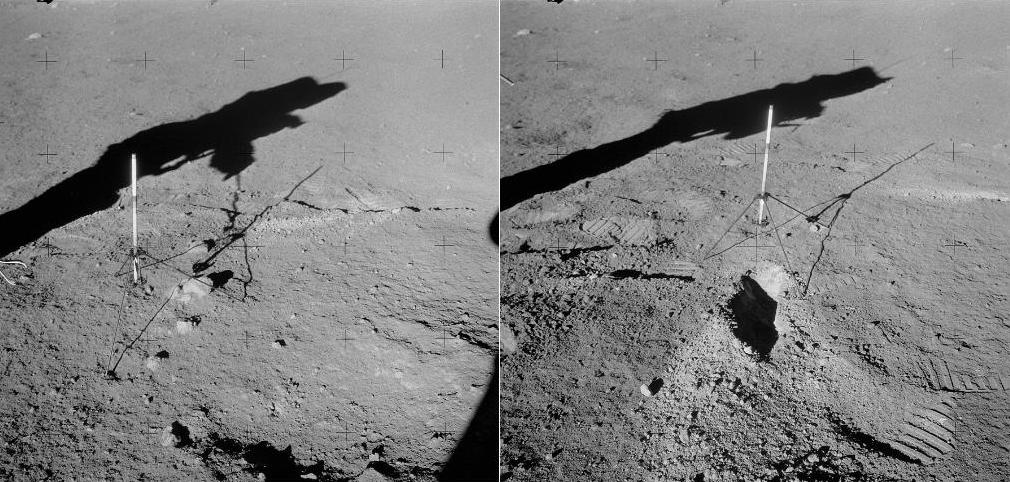 On photo AS12-48-7048 we can see on the shadow of the astronaut that he is touching the tripod with something; the problem is that on the photo we don't see the tripod touched by anything! On the next photo AS12-48-7051, the shadow is no more touching the tripod with something which never touched the tripod anyway! |
 On photo AS12-48-7071, on the visor of the astronaut (right): On photo AS12-48-7071 (Figure I.17), on the visor of the astronaut (right): - We can’t see in the visor the shadow of what the astronaut is holding with his left hand (We should see a shadow between the shadow of his arm and the one of his body). - The reflection of Conrad's camera in his visor is strange, it seems to have legs. |
 On photos AS12-49-7243 and AS12-49-7242 the bar of holes (circled in red) is oriented differently on the two photos. |
 On this pair of photos in Apollo 12 (AS12-49-7271 and AS12-49-7273) we can see the photographer's shadow, and it has the correct orientation on the two photos. So what's the problem? 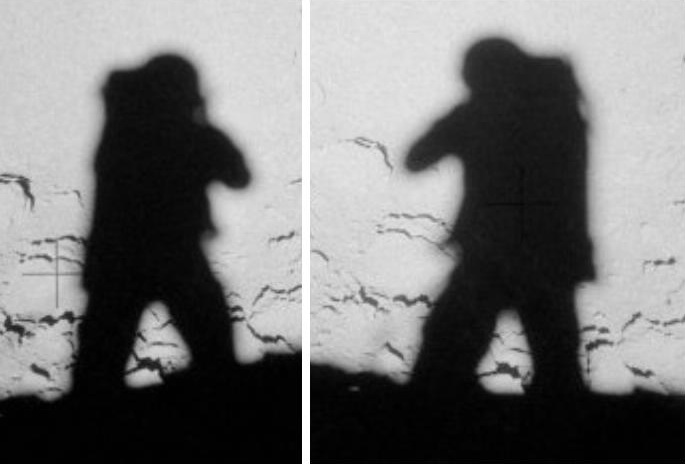 On these close-ups of the photographer's shadow of the two photos, we can see that the photographer's shadow has a quite stronger profile on AS12-49-7271 than on AS12-49-7273; yet the photographer's shadow is approximately at the same distance from the left side of the photo on AS12-49-7271 as it is from the right side of the photo on AS12-49-7273, and so the profiles should be equivalent, and not so different! |
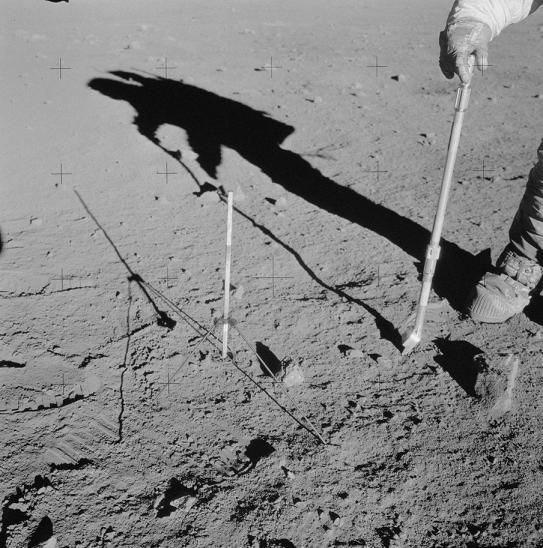 On photo AS12-49-7313 the shadow of the stick the astronaut is holding is too long comparatively with the shadow of the astronaut. |
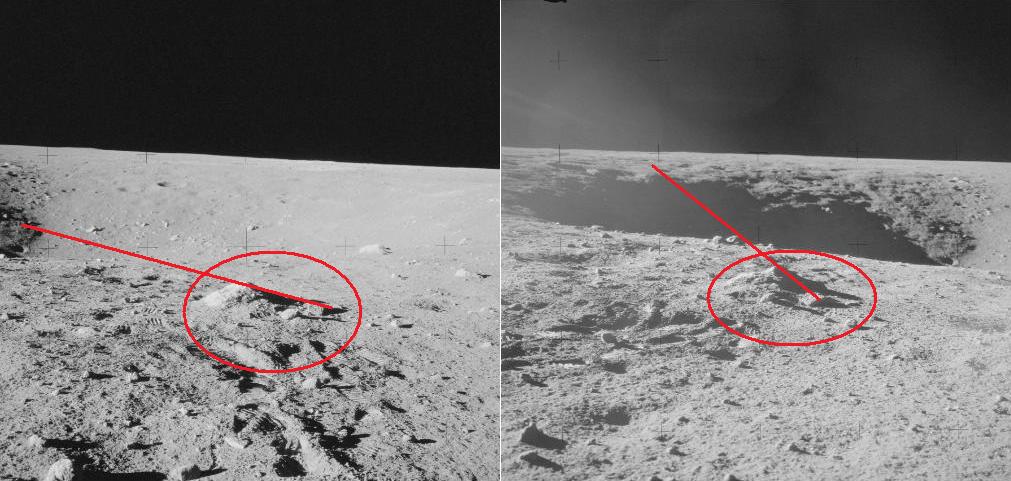 On this pair of photos in Apollo 12 (AS17-49-7182 and AS12-49-7186) we have two views of a hole with stones nearby. What's the problem with this pair of photos? 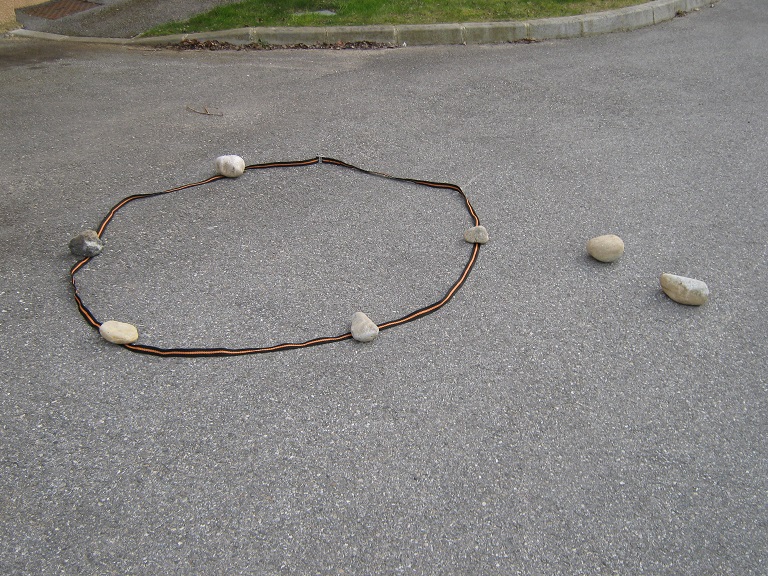 I have symbolized the hole with a ribbon (I have loaded with stones to avoid it being taken away by the wind), and two stones which are near this hole. I am going to take the hole and the two stones under angles which are close to the ones we see on the Apollo photo. 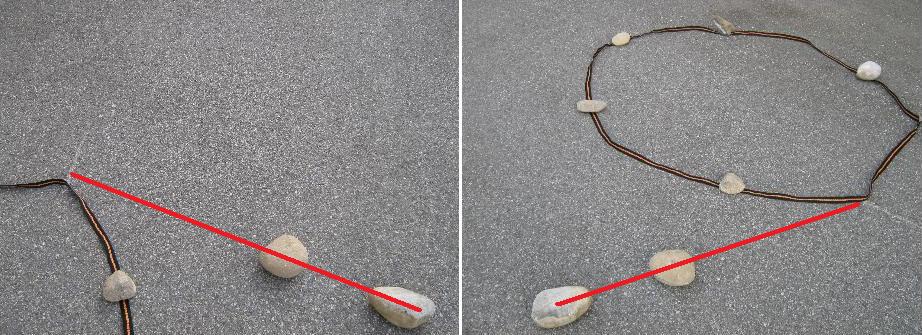 On the first photo I take a first view of the hole with the two stones. The direction of the two stones points at the beginning of the hole. And on the second view taken under a different angle, the direction of the stones is still pointing at the beginning of the hole.  So why on the Apollo photo has the orientation of the direction of the stones so radically changed? On the first photo it points at the beginning of the hole and on the second one it points at the center of the hole! Isn't it a clear incoherence? |
 On photo AS12-48-7055 the left arm of the photographer is lowered and is holding something; the kind of thing he is holding probably also needs the other hand; in these conditions we can wonder how he could take the photo! |
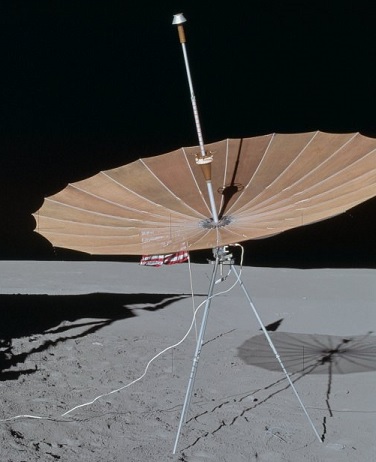 All the antennas communicating with the earth had to be oriented toward the earth, and, as the earth is seen under an angle of 2° from the moon, they even had to be oriented with a quite good precision. It was the case of the high-gain antenna of the rover, but also the case of the high-gain antenna which was just put on the lunar ground before the rover was brought on the moon (so before Apollo 15). |
 The high-gain antenna of the mission Apollo 12 and Apollo 14 had to be pointed toward the earth, like the high-gain antenna of the rover had also to be oriented toward the earth from the mission Apollo 15. |
 And, for the antenna of the ALSEP, it was the same thing; as it was communicating with the earth to send its measures, it also had to be oriented toward the earth with a quite good precision. |
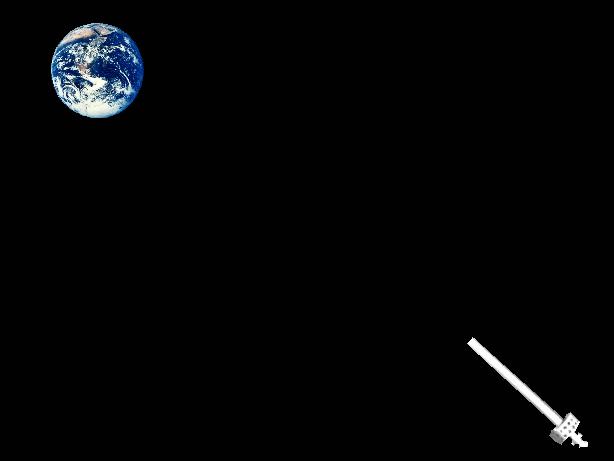 That's why the astronauts were following a process to orient the ALSEP's antenna toward the earth; this process was using the horizontality on the local site (obtained with level bubbles), and the direction of the sun (obtained with the direction of the sun's shadow), to pre-adjust the orientation of the antenna, and then they were adjusting elevation and azimuth angles from this orientation to obtain the supposed correct orientation toward the earth (in fact toward the center of the libration area in which the earth was moving). |
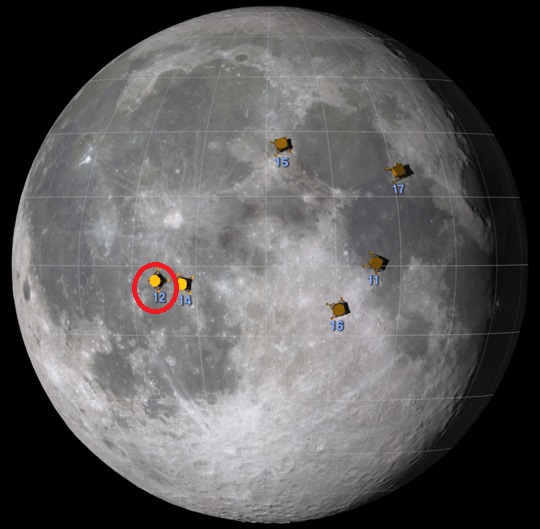 The landing site of Apollo 12 was located at 23° longitude West, and 3° latitude South (so quite close to the moon's equator). |
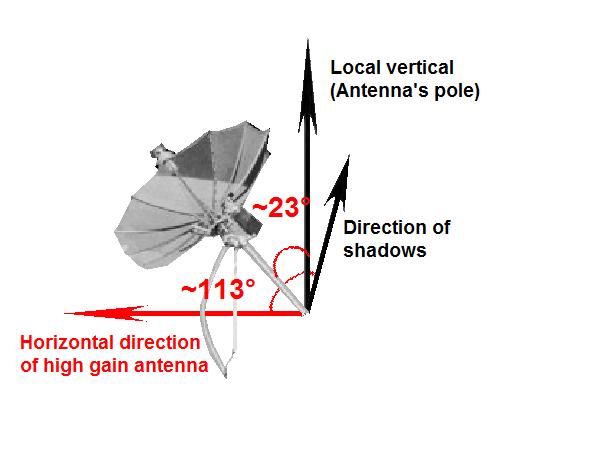 It means that the central branch of the high-gain antenna (and of the ALSEP) had to make with the local vertical an angle close to 23°, and horizontally, the central branch (of both the high gain antenna and the ALSEP) had to make with the direction of shadows an angle of around 113° left (so a little more than a quarter of a turn). We are going to see if it is the case on the photos of Apollo 12. |
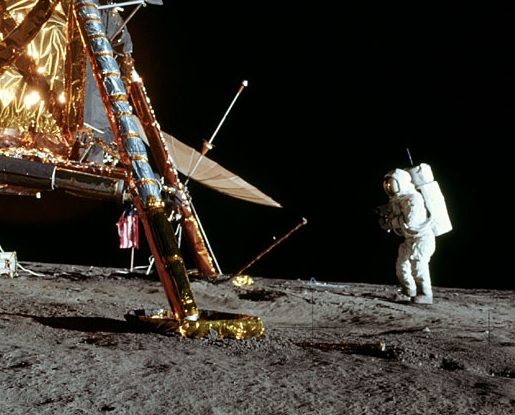 On this photo (AS12-46-6779), the high gain antenna does not make an angle of a little more than a quarter of a turn on the left of shadows. It would rather look toward the sun. |
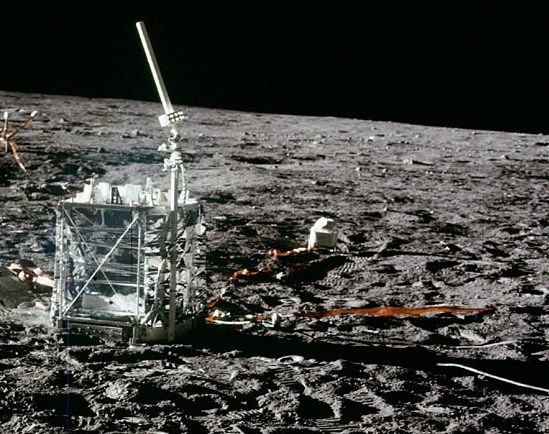 On this photo (AS2-46-6817), the ALSEP's antenna does not either make an angle of a little more than a quarter of a turn on the left of shadows. It also rather looks toward the sun. |
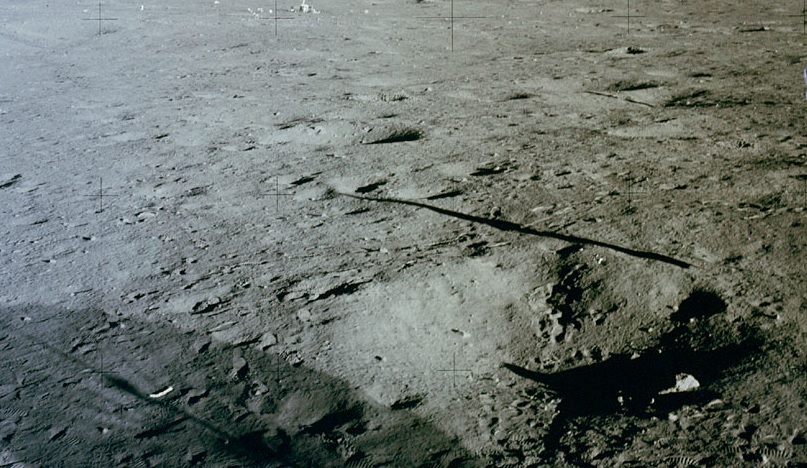 On this photo (AS12-46-6862), it is very visible on the high gain antenna's shadow (the shadow of its central branch) that it does not make an angle of a little more than a quarter of turn relatively to the direction of shadows, it is aligned with the direction of shadows; it is either in the same direction as the one of the shadows, or in opposition to it; and, if we look on other photos, it is in opposition with the direction of shadows (i.e. it looks toward the sun). |
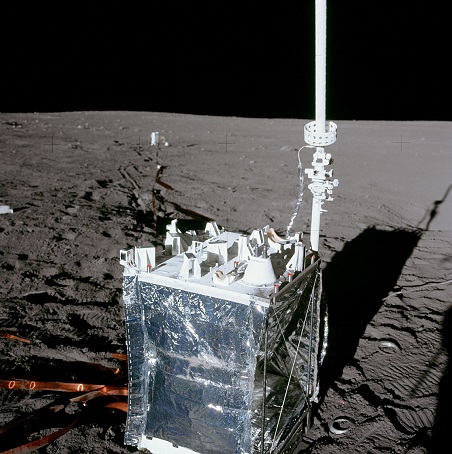 On this photo (AS12-47-6927), the ALSEP's antenna does not make an angle of a little more than a quarter of a turn relatively to the shadows; it is in opposition to the direction of shadows (i.e. it looks toward the sun, like the high-gain antenna). |
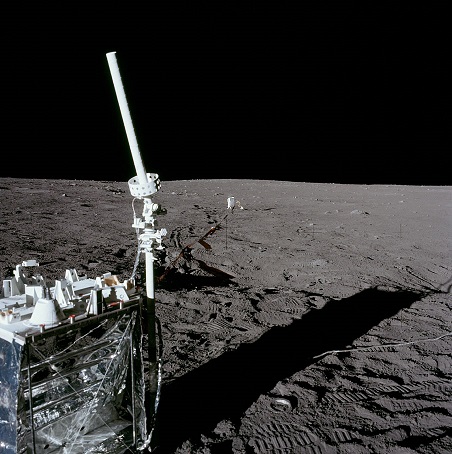 On this photo (AS12-47-6930), the ALSEP's antenna is also oriented in opposition to the direction of shadows (i.e. it looks toward the sun). |
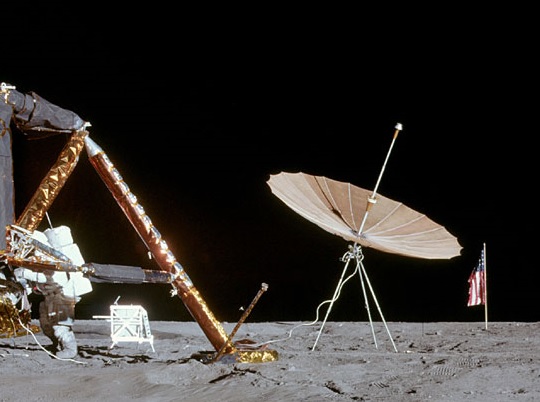 On this photo (AS12-47-6980), the high-gain antenna is oriented in opposition to the direction of shadows (i.e. it looks toward the sun). |
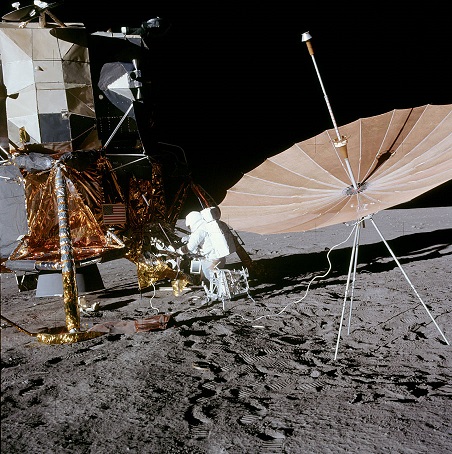 On this photo (AS12-47-6988), the high-gain antenna also looks oriented in opposition to the direction of shadows (i.e. it looks again toward the sun). |
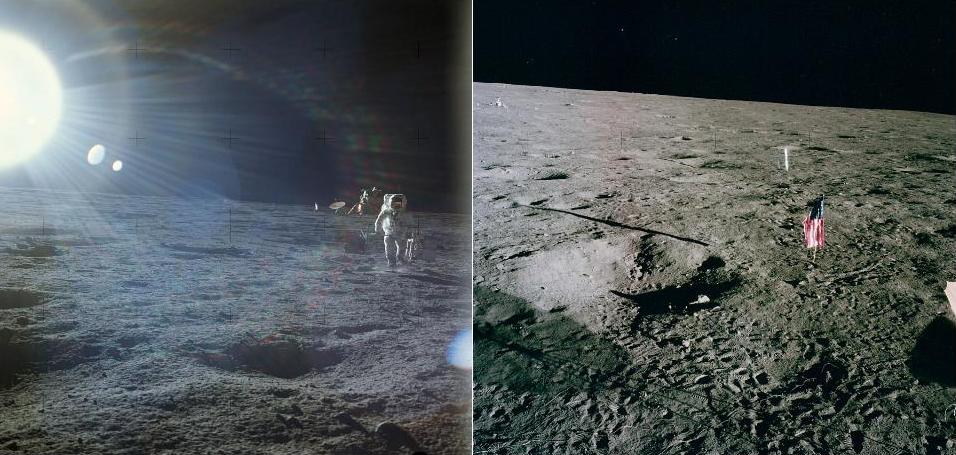 The astronauts photographed the sun at the beginning of the mission (AS12-46-6806); they also gave us a photo of the flag with his full shadow at the same time (AS12-46-6866). |
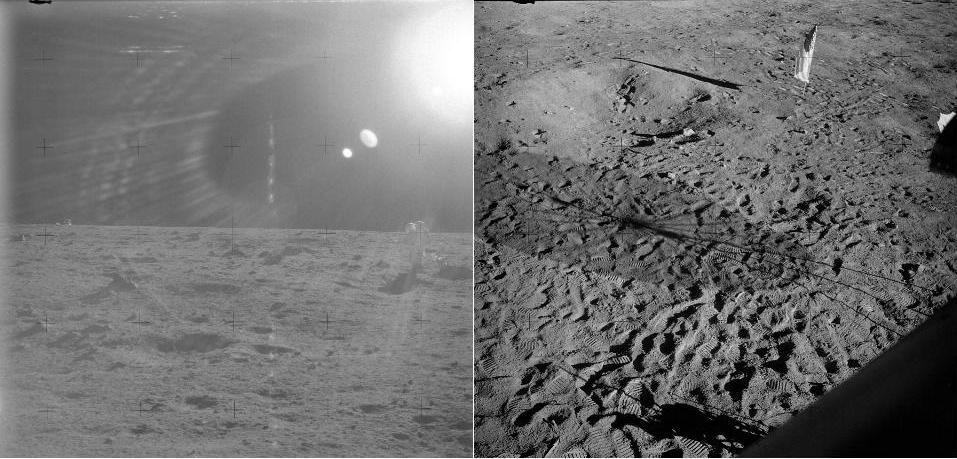 The astronauts also photographed the sun at the end of the mission (AS12-49-7246); they also gave us a photo of the flag with his full shadow at the same time (AS12-48-7160). |
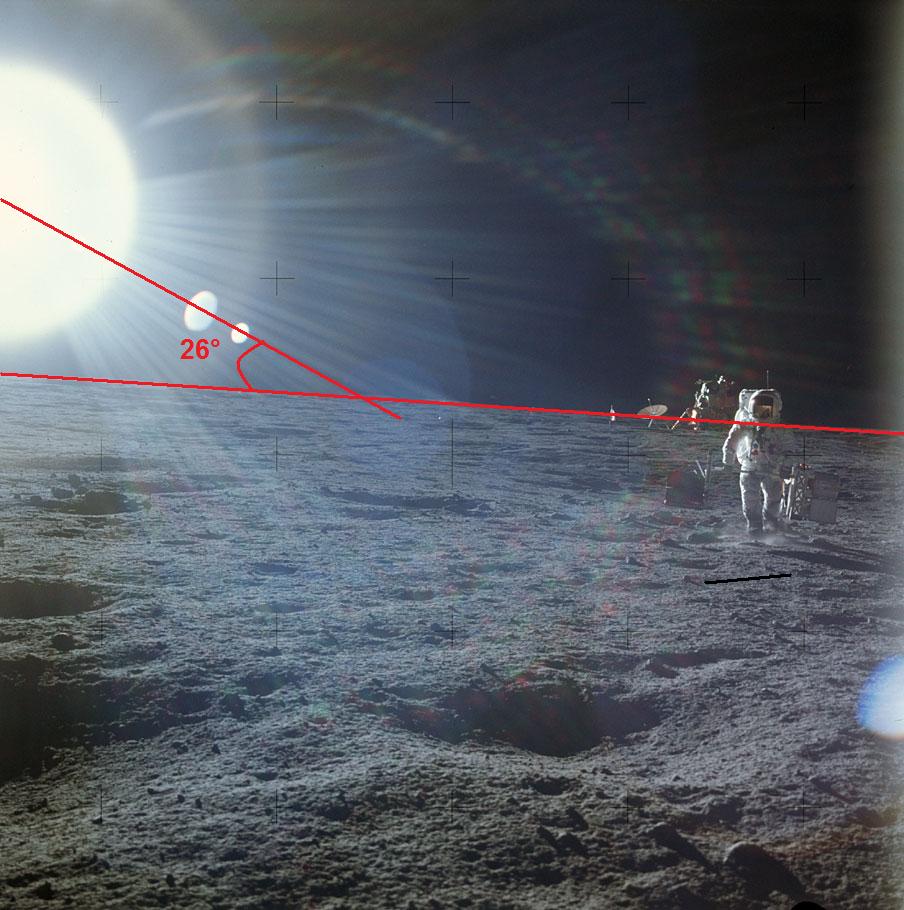 On the photographs of the sun, the fakers exceptionally gave us three reflections; the third one is inside the sun (if you don't see, then your contrast and luminosity may be badly adjusted). These three reflections allow us to draw the direction of the sun with a good accuracy. The fakers also gave us a good depth in the landscape, and a excellent horizon line. This allows us to measure the angle of the inclination of the sun at the start of the mission with quite a good precision. I drew the lines on a print copy, and I measured the angle between the lines and found an angle of 26°. |
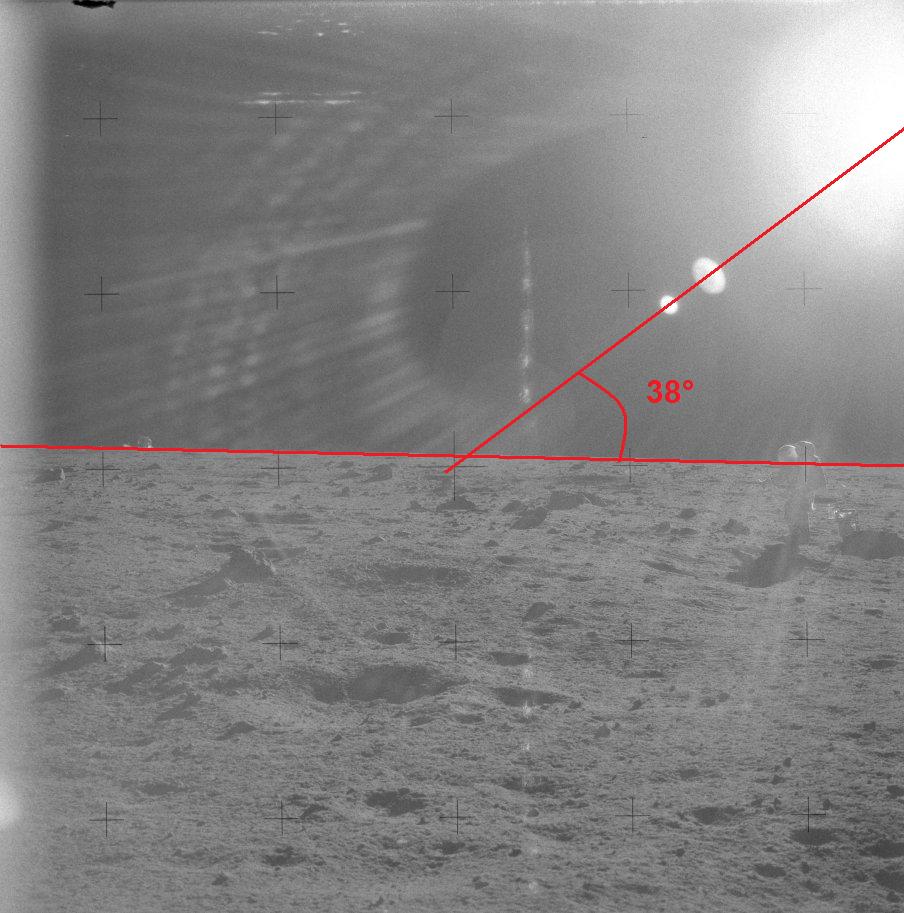 I did the same on the photograph of the sun at the end of the mission (with the same properties: the three reflections for the sun, and good depth for the landscape), and this time, I found an angle of 38°. The inclination of the sun also determines the lengths of the shadows. It was interesting to have the lengths of the shadows of the flag at the beginning and the end of the mission on the same photo. |
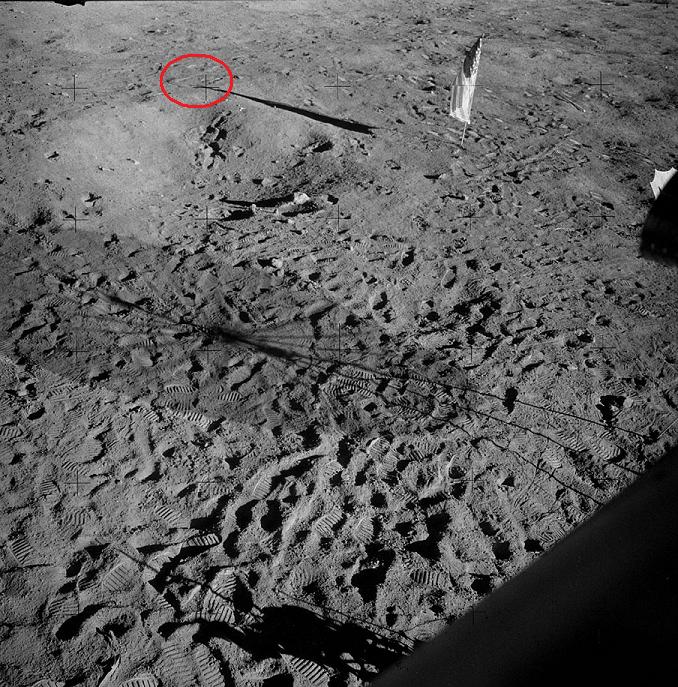 On this photo of the flag at the end of the mission (AS12-48-7160), we can see that at the location of the end of the flag's shadow, there is precisely a very convenient artifact I have circled. |
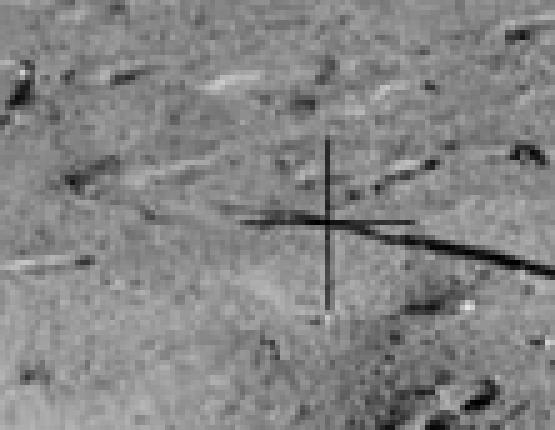 On this close-up of the end of the flag's shadow, we better see this artifact. |
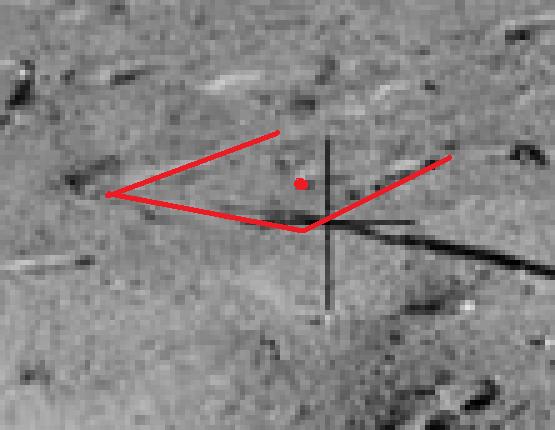 I have underlined the artifact in red; A hole between the two edges of the artifact marks the end of the shadow. |
 On the photo of the flag at the beginning of the mission, we find the same artifact. |
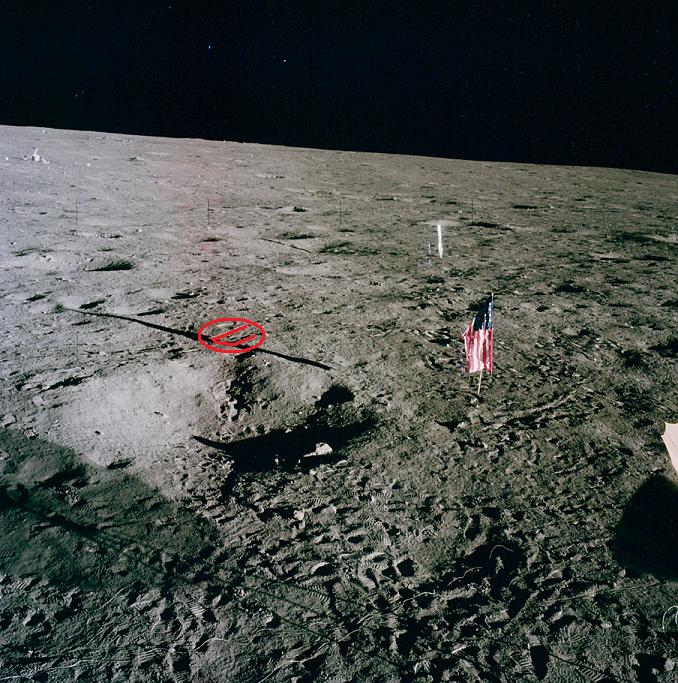 I have underlined it in red in case you wouldn't see it. So now, we can see the end of the shadow of the flag at the beginning and the end of the mission on the same photo. |
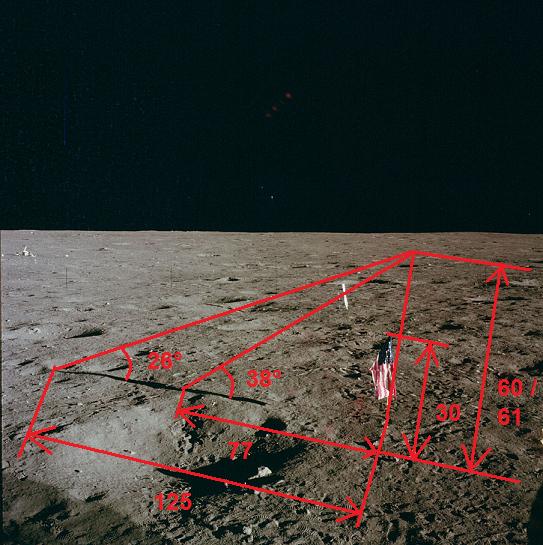 I have made a print copy and measured the two lengths of the shadow of the flag: I have found 125mm for the shadow's length at the beginning of the mission, and 77mm for the length at the end of the mission. Since we also have the angles of the direction of the sun at the beginning and the end of the mission, we can calculate at what height these lengths correspond. For the beginning of the mission: Flag's height = 125 * tan(26°) = 60.9 mm for the end of the mission: Flag's height = 77 * tan(38°) = 60.1 mm You can see that it's quite close! The problem is that when I measure the height of the flag on the same print copy, I only find 30mm, twice less! |
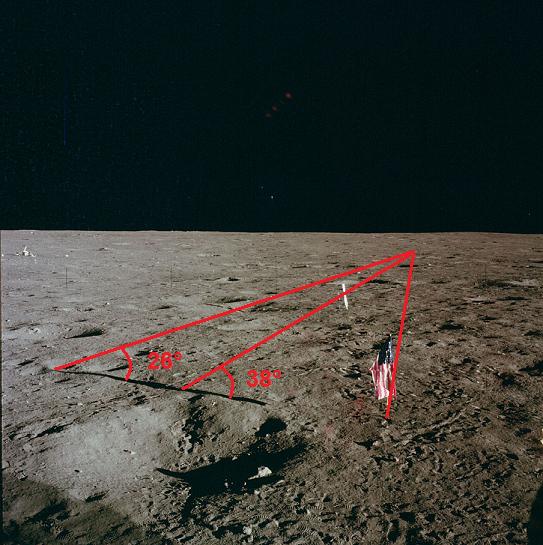 And even if there is a correction to make due to the perspective, it still makes a lot of difference, too much! |
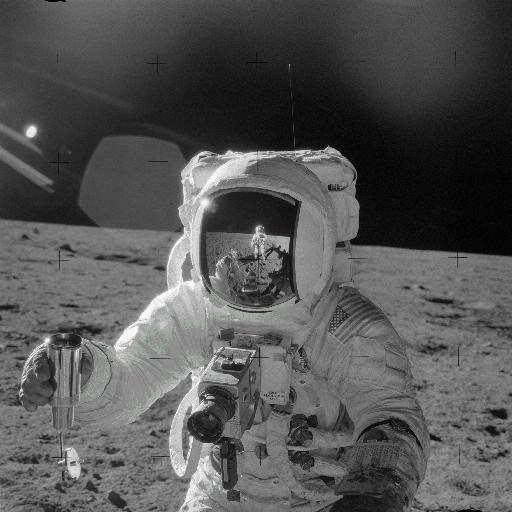 This photo is a photo of Apollo 12 supposedly showing Alan Bean holding a sample container full of lunar regolith. This is what Phil Plait has to say about it: "This is a picture of Al Bean. It’s a man in a space suit. It’s a man in a spacesuit holding a sample container. It’s a man in a spacesuit holding a sample container on the Moon. Standing on the Moon. It’s a man standing on the freakin’ Moon! Slowly, a wave of awe, joy, and happiness washed over me — a glow of warmth that stays with me to this day. From that moment on I didn’t let the conspiracy theorists bug me very much. They were wrong, but even more importantly, they didn’t matter. In the long reach of history, they will be forgotten, gnats buzzing around a monumental edifice." This photo is effectively the most remarkable one of Apollo 12, but not at all in the way Phil Plait thinks it is. After I have shown the incredible anomalies it is filled with, the irony of his admiration for this ridiculous photo will appear in full. |
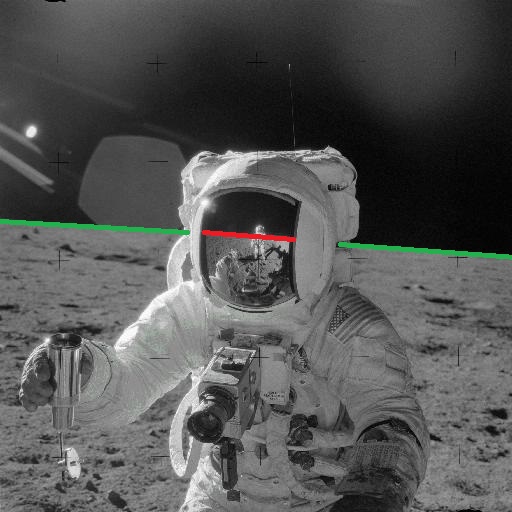 First, what is striking on this photo, and I am not the first one to notice it, is that the reflection of the horizon line in the visor is aligned with the horizon line of the photo. Of course, the Apollo believers are going to say that it is just a "coincidence". |
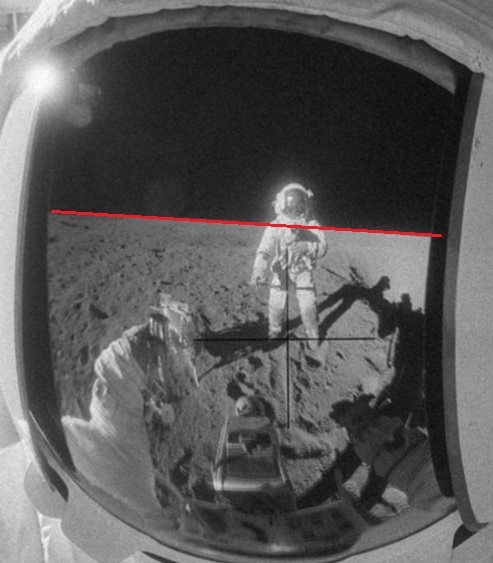 But, what they will have more trouble to explain is that, whereas the visor is curved, and thus the reflection of the horizon line should normally be curved, it appears straight, like the visor was flat. |
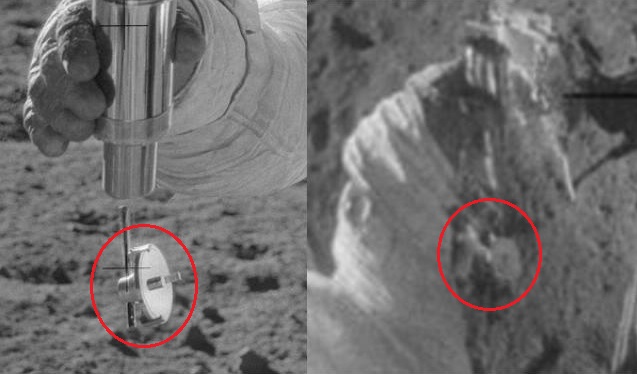 At the bottom end of the sample container Bean is holding, we can see a wheel (left of the double view); but, in the reflection of the visor (right of the double view), it is not just one wheel we can see, but two instead (and not oriented the same)! |
 On the photo, there is a watch strapped around his left arm (left of the double view)...but, in the reflection of the visor (right of the double view), we cannot see this watch on his left arm! (his left arm appears right on the photo, of course). |
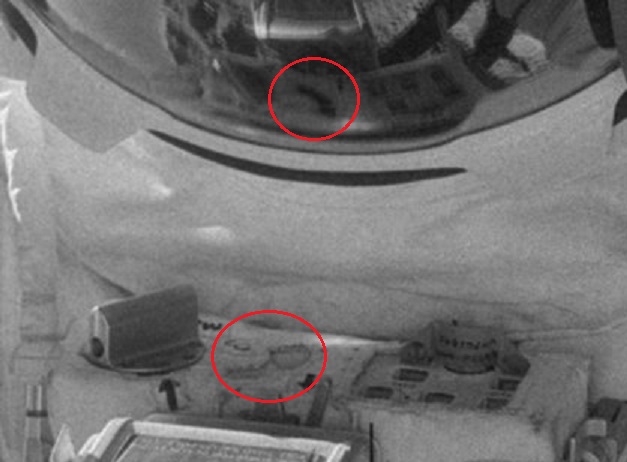 On the support of the camera, near the visor, we can see an element, I have circled, which appears clear on the photo, but dark on the reflection of the visor. |
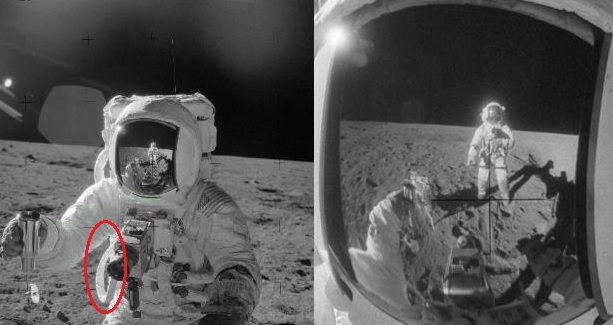 There is a white strap which appears on the left of the camera on the photo and which does not appear on the reflection of the visor. |
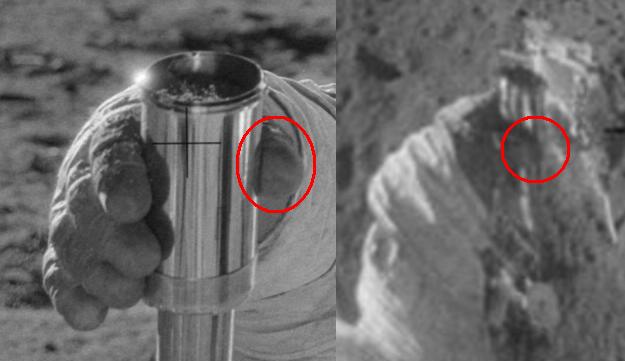 On the photo, the thumb of Alan's hand which is holding the sample container goes beyond the container...But not on the reflection of the visor. |
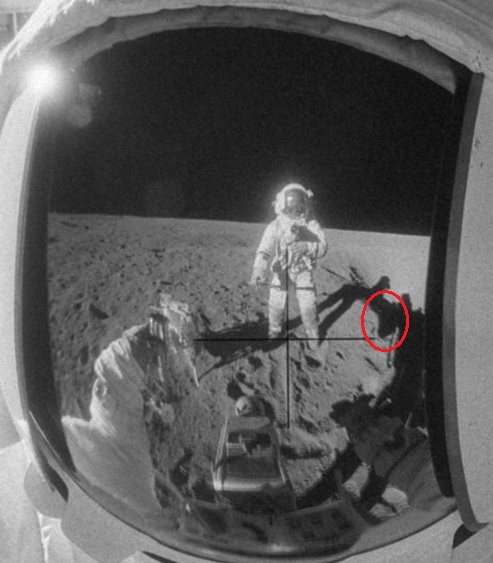 There is a deviation of the shadows of the astronauts because a depression of the terrain in the reflection of the visor...But there is a bit of shadow, I have circled, which is before the place that the shadows are deviated, and which thus has no rational explanation. |
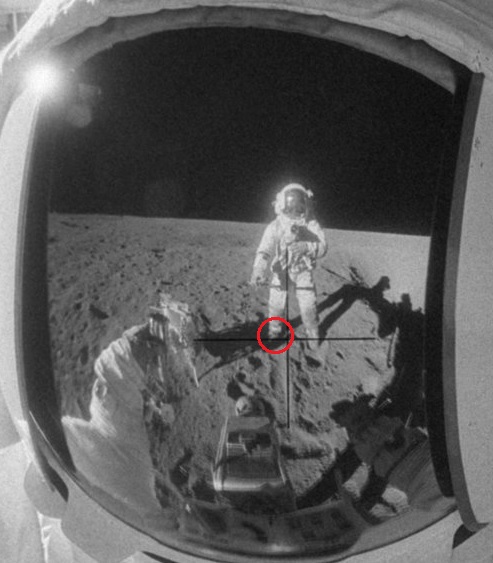 There is a device which is before Pete Conrad, and of which the shadow partially covers Pete's left leg in the reflection of the visor...Yet, the bottom of this leg is not shaded by the device's shadow. |
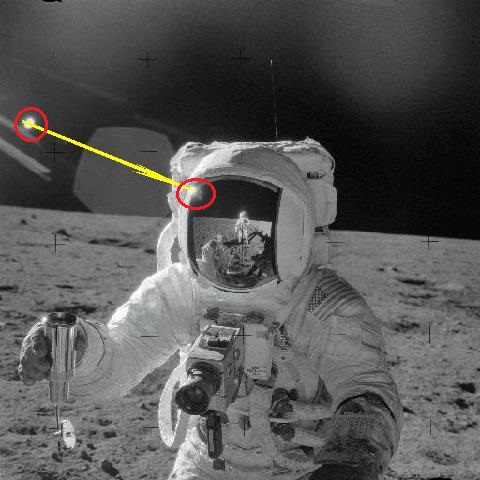 We can see the reflection of the sun on Bean's visor, and we can also see a lens flare; I have circled both of them, and, by joining them with a line, we obtain the exact direction of the sunlight. |
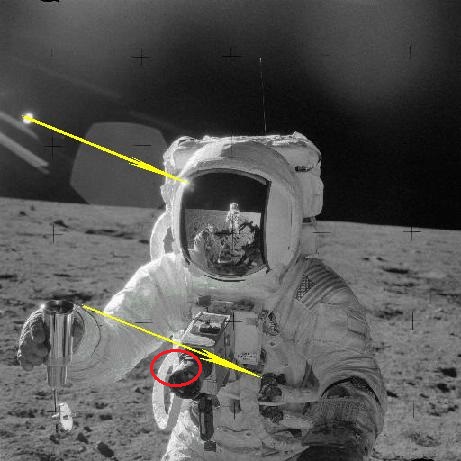 Now, if we draw the same direction from the top of Bean's right elbow (left on the photo), we can see that this direction goes over the objective of Bean's camera; this means that this objective should be entirely shaded, that Bean's arm entirely blocks the sunlight from it. Yet we can see that there is a part of it, I have circled, which should logically be shaded by Bean's right arm, and which still manages to be lit! |
The vertical position of the reflection of a light source on a spherical glass ball depends on the height of this light source. |
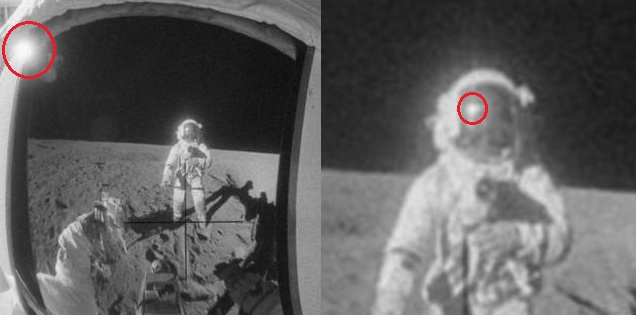 The visors of the two astronauts are the same, both spherical, and they receive the sunlight from the same direction, so, logically, the reflection of the sunlight should be at the same height on the two visors; yet you can see that, whereas the reflection of the sunlight on Bean's visor is at the very top of the visor, it is lower on Pete's visor. |
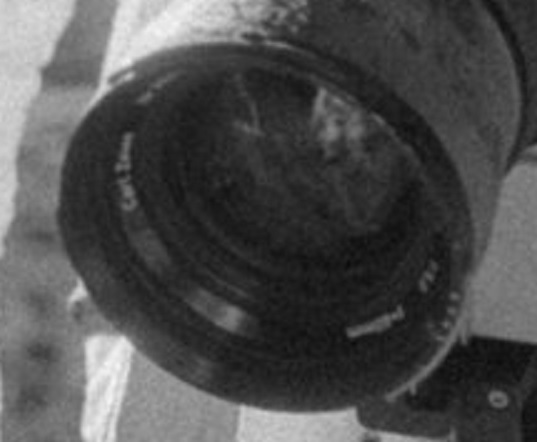 Finally, on the reflection of the lens of Bean's camera, we can see the legs of Pete Conrad on the top right, while he appears on the center of the visor. |
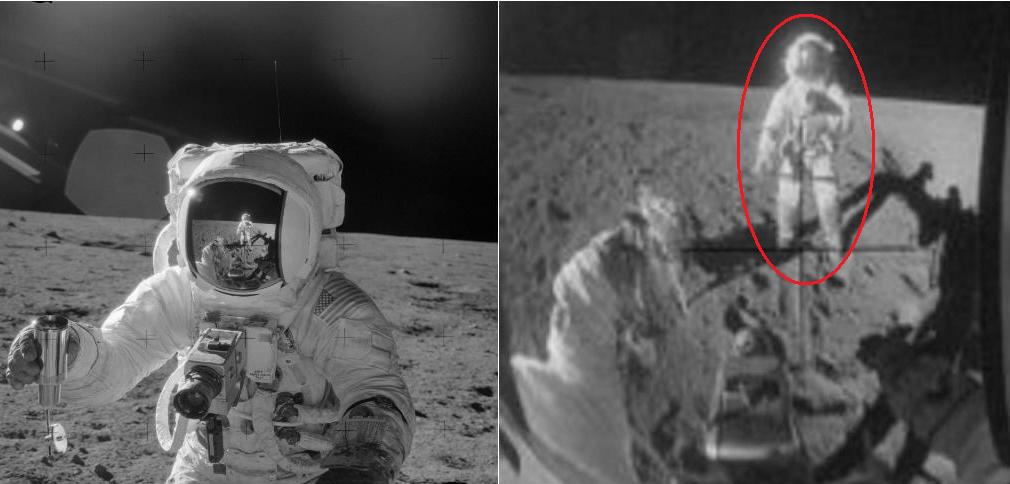 Last hint: Given the oblique orientation of the visor, turned clockwise, the photographer should also appear turned clockwise in the visor; instead of that, he appears turned counter-clockwise. |
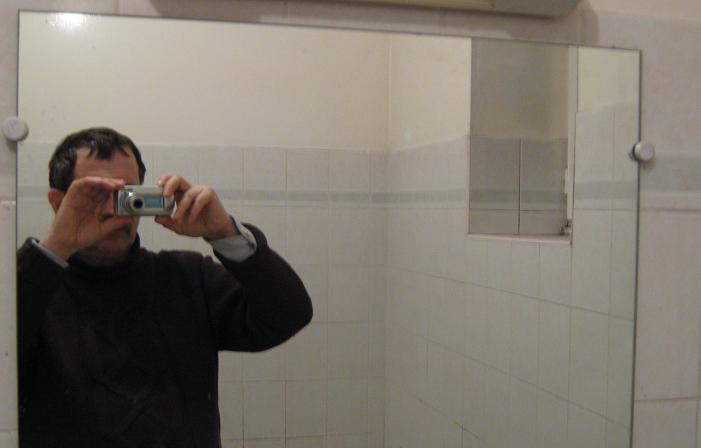 When you take a mirror in photo, which one is in bias, you appear turned the same way in the reflection of the mirror: If the mirror is turned clockwise, you also appear turned clockwise, and vice versa. |
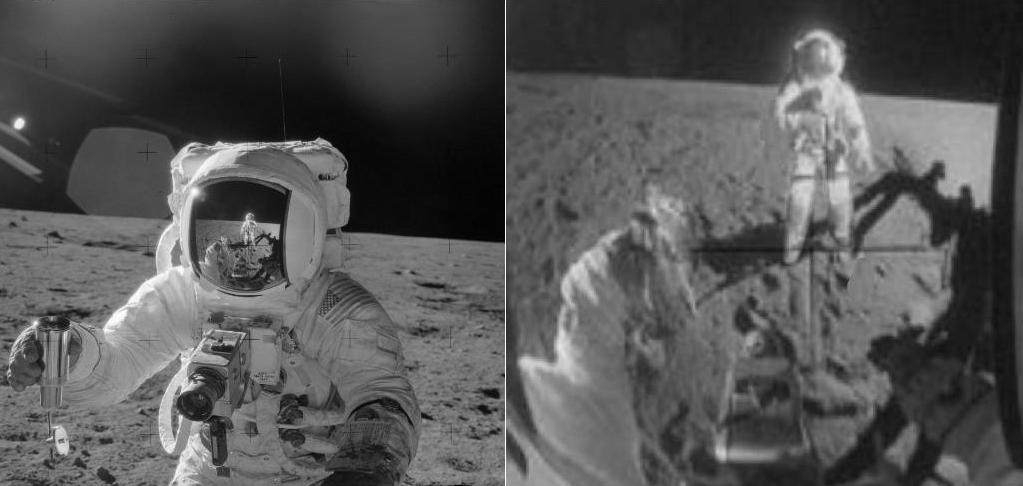 On this visor I have corrected the orientation of the photographer to turn him clockwise (except of course that, by inverting the astronaut, I have also inverted the direction of the sunlight). 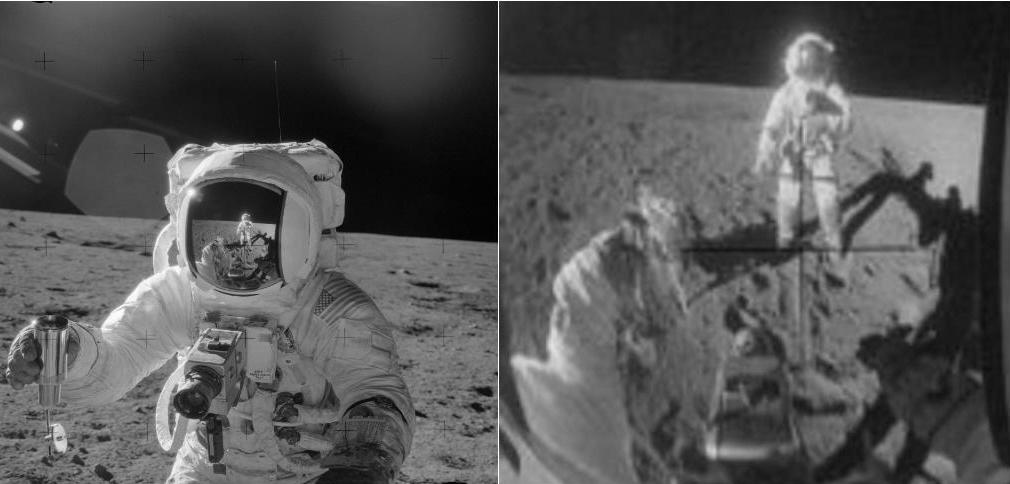 But there is still something more remarkable; look at the reflection of Pete Conrad in the visor: HE DOES NOT WEAR HIS BACKPACK. How can he breathe? |
 And this is this photo that Phil Plait is worshipping, that he feels so much exaltation about it! |
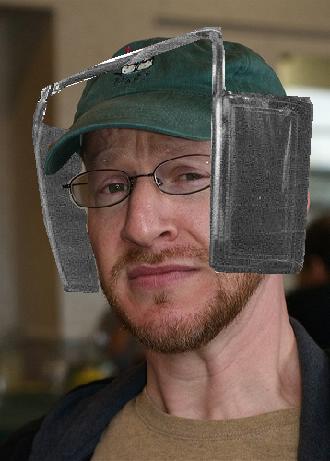 It is obvious that Phil Plait has blinders, and that he has not carefully examined the photos of Apollo. |
 After the ascent module has been jettisoned in Apollo 12, it was deorbited to send it crash on the moon, and its crash be recorded by an ALSEP's seismometer. |
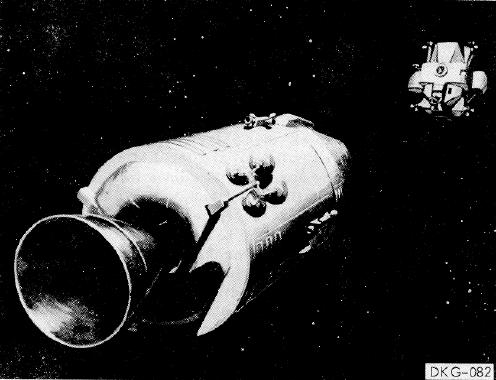 However, they say this about the way the ascent LM is jettisoned in the docking&undocking documentation: "The LM is then released by firing the separation system (detonating cord) located around the circumference of the docking ring, thus severing the ring and separating the LM. This completed, the CM SPS engine is fired placing the spacecraft in a return trajectory toward the earth". It means that, after the separation, the LM still has the orbital speed of the CM's orbit. After the separation, the power is normally terminated in the LM, it becomes like a dead body. |
During the descent to the moon, in order to gain a lower orbit, the lunar module decreases its speed; this is supposed to make it take an elliptical orbit which will make it come closer to the moon at the other end of the elliptical orbit (supposing this maneuver effectively works, so close to the moon); they say that the LM loses around 75 feet/s to catch an orbit which makes it come to a lower orbit, at the altitude of 50000 feet (15km), at the other end of the elliptical orbit (I have calculated 73 feet/s personally with the Kepler formula). |
It means that the orbital speed of the LM ascent stage should be reduced enough so that the elliptical orbit, this reduction makes it take, becomes too short and cuts the moon. I have calculated that a reduction of 85 feet/s (~100 km/h) places the LM on an orbit which touches the moon on the other end of the orbit (i.e. altitude 0). It means that the necessary reduction of speed to make the ascent module crash on the moon should at least be equal to 85 feet/s. If the LM does nothing, it will not crash on the moon. |
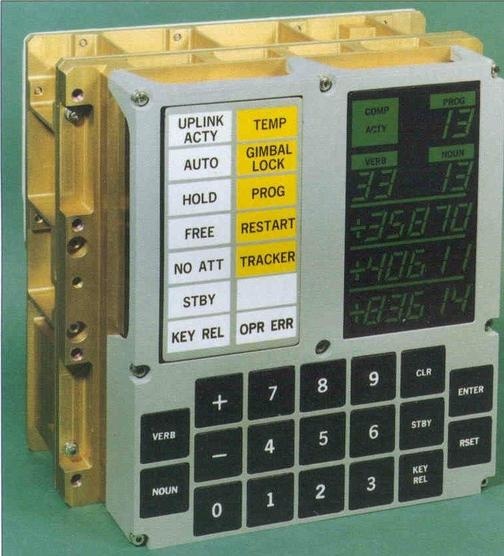 The report of the Apollo 12 mission says that the deorbit maneuver was remotely controlled, it was not pre-programmed after the separation. |
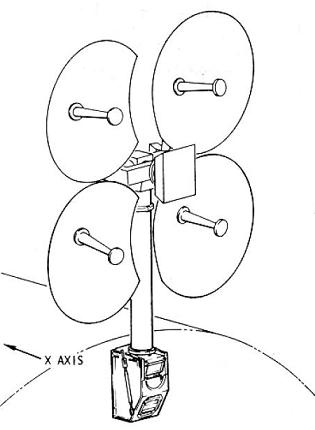 The report of the Apollo 12 mission says that there was a problem of reception from earth and emission to earth with the high gain antenna. |
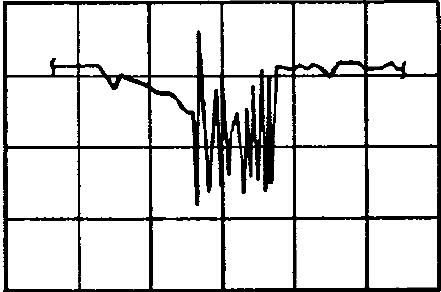 It says that the signal strength of S-Band communication was reduced both in uplink and downlink signals. |
 To restore a normal signal with earth communication, the report says that the astronauts had to switch to manual and orient the high-gain antenna toward the earth. If this is true for the large four dishes antenna of the command module, it is still more true for the smaller single dish antenna of the lunar module. It could only communicate with the earth if correctly oriented toward the earth. |
 The problem is that, not only the separation between the command module and the lunar module may have changed a little the orientation of the lunar module (if we believe this illustration), but moreover, as the lunar module orbits the moon, the orientation of the S-Band antenna relatively to the earth constantly changes (and, as the LM is planned to crash not far from an an ALSEP tracking station, the deorbit maneuver is not immediately commanded, which means that the LM makes some travel around the moon after the separation before the deorbit command is sent). |
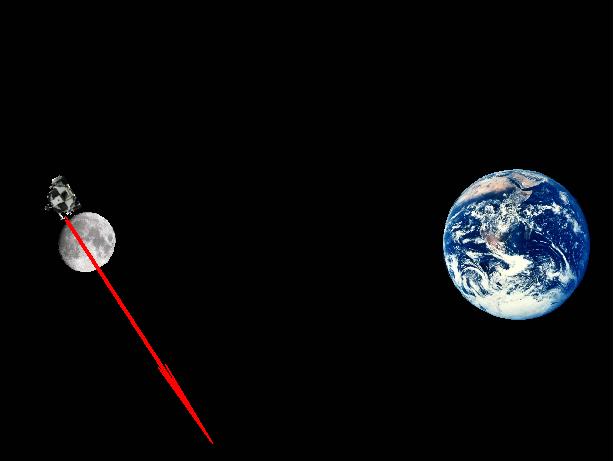 So, it is probable that, at the moment that the ground sends the command to deorbit the LM, its S-Band antenna is not correctly oriented and does not point toward the earth; the consequence is that the LM cannot receive the deorbit command, nor execute it. If the astronauts had been aboard, they could have reoriented the antenna for a proper communication with the earth, but, as they are no more aboard, there is nobody to make this task. |
OK, let's suppose that the S-Band antenna of the LM was miraculously oriented toward the earth at the moment that the deorbit command had to be sent, that the ground could telemeter down the deorbit command, and that the LM could execute it (let's believe in miracles!). |
 Hamish Lindsay says this about the impact of the ascent module of Apollo 12 on the moon: "When the Apollo 12 LM hit the lunar surface at 6,048 kilometers per hour, 72 kilometers from the landing site, digging an estimated 9 meter wide crater, the results were astonishing. All 3 seismometers in the package recorded the impact, which set up a sequence of reverberations lasting nearly an hour." And he shows this recorded plot of the event. |
But, in fact, when the LM crashes on the moon, it has a very important horizontal speed, but a relatively moderate vertical one; the important horizontal speed indeed creates a centrifugal force which counters most of the lunar attraction, and allows the vertical speed to increase only moderately. |
It means that the crashing LM will hit the lunar surface almost horizontally; it will scrape the lunar surface rather than digging a local deep crater. |
In earth atmosphere, it would have been much different, because the atmosphere slows down the important horizontal speed which converts into vertical speed instead. If the moon had had an atmosphere like the earth, the lunar module would have hit the lunar surface vertically with a great speed. |
But the moon has no atmosphere to slow down the important horizontal speed of the lunar module, and it is thence mostly horizontally that the lunar module hits the lunar surface. Besides, the fact that the LM hit the lunar surface almost horizontally is confirmed by this phrase in the mission report of Apollo 12: "The angle between the impact trajectory and the mean lunar surface was 3.7 degrees at the point of impact.' |
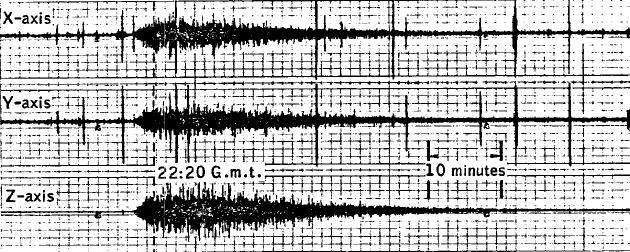 Yet, if we examine the plots of the three seismometers along the three axes (that I found in the mission report of Apollo 12 - Lindsay was only showing the one along the vertical axis), we can see that the plot along the vertical axis has more amplitude than the plots along the horizontal axes, when it should be the converse since, as I mentioned earlier, the impact of the LM on the lunar surface is mostly horizontal. Consequently it is the plots along the X and Y axes which should show the greatest amplitude, and the plot along the Z axis consistently less (it should have around the tenth of the amplitude of the horizontal plots). |